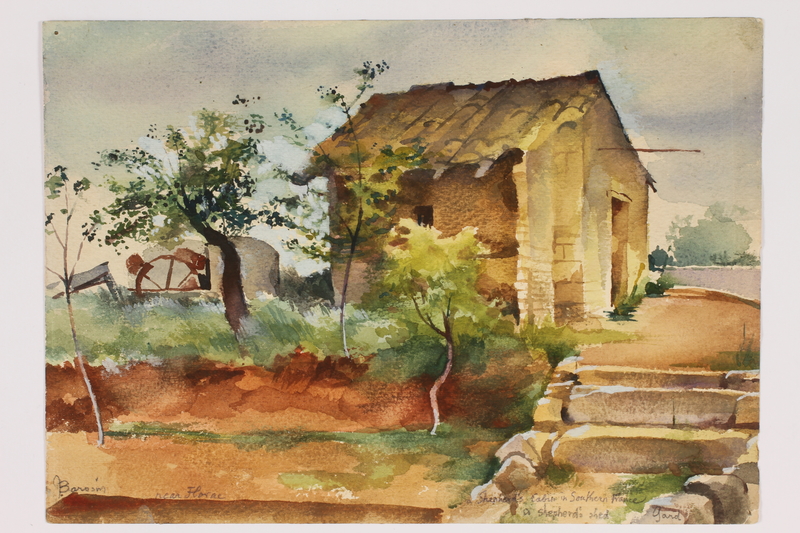Overview
- Brief Narrative
- Painting depicting a rural cabin near Florac, a town in France where Jacob and Sonia Barosin hid between November 1942 and April 1943. In June 1933, Jacob and Sonia Barosin (previously Judey) immigrated illegally to Paris, France, in order to escape the anti-Jewish laws passed following the appointment of Adolf Hitler as chancellor of Germany in January. Jacob voluntarily enlisted in the French military following the 1939 German invasion of Poland. In May 1940, Germany invaded France, Jacob and Sonia were arrested as enemy aliens, and Sonia was transported to Gurs internment camp. On June 2, Jacob was transported to Langlade, to serve as a prestataire. Sonia was released from Gurs and travelled to Nice. On May 15, 1941, Jacob was released and moved to Lunel, where Sonia joined him in April 1942. In mid-October, Jacob was sent to Agde internment camp. A friend of his father worked in the camp office and arranged for him to return to Lunel. German forces occupied Lunel in November, so Jacob and Sonia fled to Florac. On February 17, 1943, Jacob was arrested and transported to Gurs, and then sent to a labor camp in Gignac on March 21. Jacob returned to Florac on April 17, and teacher Simone Serriere hid Jacob and Sonia in her schoolhouse in Montmejean. After they were discovered by townspeople, Sonia’s cousins, Boris and Paulette, brought them forged identity papers, and they all returned to Paris in September. Jacob and Sonia were given refuge by Paulette’s mother, until Paris was liberated in late August 1944. The majority of Jacob’s family survived, though his Latvian relatives and his sister, Sina Ida, were murdered during the Holocaust.
- Artwork Title
- Petite maisonette dans la vigne
- Alternate Title
- Small house in the vineyard
- Date
-
depiction:
1942 November-1943 April
- Geography
-
depiction:
Florac (Florac, France)
- Credit Line
- United States Holocaust Memorial Museum Collection, Gift of Peter Garik and Katherine Greenblatt
- Markings
- back, upper left corner, handwritten, pencil: petite maisonette dans la vigne [Small house in the vineyard]
- Signature
- front, bottom left corner, handwritten, pencil: Barosin
- Contributor
-
Artist:
Jacob J. Barosin
Subject: Jacob J. Barosin
- Biography
-
Jacob Judey (later Barosin, 1906-2001) was born in Riga, Russia (now Latvia), to Lazar Hirsch (later Hermann, 1878-1959), and Olga Elka (née Fischmann, 1878-1929) Judey. Jacob had a half-brother, Paul Berkowitz (1897-?), from his mother’s first marriage, and three sisters: Lydia (later Kaminsky, 1903-1976), Miriam (later Mary Mangold, 1908-2003), and Sina Ida (1912-?). Jacob’s family fled Riga before World War I (1914-1918) and settled in Berlin, Germany, where Lazar built a plywood import business. After graduating, Jacob attended the University of Berlin where he met Sonia Finkel (1904-1973), a talented violinist who was born in Bessarabia (now Moldova). She and her parents, Isaac and Victoria (née Nemirovska) Finkel, fled from Odessa, Russia (now Ukraine), following the Russian Revolution (1917). Jacob and Sonia married in 1927, the same year that Paul sailed to Montevideo, Uruguay. In 1932, Jacob received a doctorate in art history from the University of Freiburg. Following Olga’s death, Lazar married his second wife, Sonja Sara (Sonia Sophie, née Veksler, 1903-1996), and the couple had a daughter, Eugenie (later Jeanie Dubnau, b.1938).
On January 30, 1933, Adolf Hitler was appointed chancellor of Germany, and the authorities quickly began suppressing the rights and personal freedoms of Jews. In June, Jacob and Sonia travelled to Paris, France, on a four-week visa and never left, preferring to live as stateless foreigners in France. Jacob and Sonia changed their surname to Barosin. Jacob worked as a salesman for a printing shop, and Sonia as a seamstress. They spent a lot of time with Sonia’s cousins, Boris Guervit and Jacques, and their wives, Paulette and Jeanne. Miriam, Lydia, and their husbands, Dr. Ernst Mangold and Dr. Anatol Kaminsky, also immigrated to France.
Following the German invasion of Poland on September 1, 1939, Jacob voluntarily enlisted in the French military. On May 10, 1940, Germany invaded France. Eight days later, French police arrested Jacob and Sonia as enemy aliens and separated them. On May 25, Sonia was transported to Gurs internment camp in the Pyrenees Mountains. On June 2, Jacob and 20 others who had enlisted were transported to Langlade, to serve as prestataires, foreign workers attached to French army. Jacob sent Sonia a certificate indicating his position in the prestataires, which she used to secure her release on June 25. The day after she joined him, Jacob altered her safe conduct pass from Gurs to avoid arrest by the police. She travelled to Nice where they knew people that could help get her a residence permit.
The June 1940 armistice between France and Germany made the prestataires unnecessary, and Jacob knew he needed to leave before his group was disbanded. In August, he got a pass to visit Sonia under false pretenses. He managed to stay in Nice with Sonia, until he was arrested on October 5. Jacob returned to Langlade because he had not been properly discharged from the military. To avoid being sent to salt mines, Jacob and his roommates began painting and selling patriotic doormats in support of Philippe Pétain, the leader of unoccupied Vichy France. They donated the money to the National Aid Society and received a letter of thanks from Pétain, which impressed the camp commandant. On May 15, 1941, Jacob was released and made his way to the town of Lunel, where the prefect of Herault was willing to issue a residence permit. He was only permitted to work as an agricultural laborer, so Jacob found a part-time position on Roger Dussel’s farm.
Sonia remained in Nice until early April 1942, so that she could continue to earn money as a seamstress. In mid-October, Jacob was ordered to report to Agde internment camp. Jacob and Sonia asked Pastor Pierre Charles Toureille, the husband of an acquaintance, for help regarding Jacob’s internment. He agreed to help Jacob by writing a letter of support. Once at the camp, Jacob presented the letter to a clerk, who happened to be a good business friend of his father’s. The clerk “detached” Jacob from the camp to continue working on the Dussel farm. Jacob returned to Lunel, and under the new arrangement, he was not required to revisit the camp.
In mid-November, the German forces occupied Lunel, which prompted Jacob and Sonia flee to the town of Florac. By chance, Jacob met Ernest Audrix, who rented them an apartment in Florac and connected them to a network of aid and protection for Jews in that town. On February 17, 1943, Jacob was arrested and transported to Gurs. Upon arrival, he used a copy of his father’s passport to claim Latvian citizenship, which would keep him off the transport lists of German Jews. On March 21, Jacob was placed in a group of twenty men loyal to France and transported to a labor camp in Gignac. When the laborers were told that there would be no travel permits for Passover, Jacob suspected a deportation was planned. He claimed that Sonia was sick, and begged the office clerk to issue a travel permit for the two days before the restriction was scheduled to begin. The clerk wrote out the permit, and Jacob returned to Florac on April 17.
A local pastor, Andre Gall, spoke with a schoolteacher, Simone Serriere, who agreed to hide Jacob and Sonia in a small room above her schoolhouse in Montmejean. She agreed to supply food and water, so long as they remained quiet while she was teaching. During the day, Jacob and Sonia used a pail as a chamber pot, and they could only empty it late at night. One evening, Jacob emptied the pail early, and someone heard him. The following day, Simone arrived to find the townspeople surrounding the school because they knew someone was hidden inside. Simone explained that she was hiding a French couple because they feared being sent to Germany as factory laborers, and avoided mentioning that they were Jewish. Although Jacob and Sonia were assured by the townspeople that they would be safe, they felt too many people knew they were there. They wrote Boris in Paris, asking him and Paulette to visit - a code for needing help. In August, Boris and Paulette brought them forged identity papers under the names of Michel and Maria Potapoff. On September 1, Boris and Jacob returned to Paris, and once it was safe, Sonia and Paulette followed. Jacob and Sonia were given refuge by Mrs. Mallet, Paulette’s mother, in Soisy-sous-Montmorency. They remained with her until Paris was liberated in late August 1944, and soon after returned to their old apartment, which was still intact. In May 1945, Germany surrendered.
Following the war, Jacob was still only allowed to work as an agricultural laborer, making it difficult to find a permament position in France. Moreover, he and Sonia were denied French citizenship, so they applied for US visas. They arrived in New York City aboard the SS Marine Falcon on October 21, 1947. They joined Jacob’s father, stepmother, half sister, sister Lydia, and her husband, who had all fled in 1942 from southern France for the United States via Casablanca, Morocco. Jacob’s youngest sister, Sina, died in Riga, where she had been staying with relatives. Miriam and her husband hid in France until the end of the war, and arrived in the US in 1948. While living in the US, Jacob became an illustrator, created illustrations for the Jewish Family Bible, and worked for NBC television. After Sonia passed away, Jacob married Natalie Stein Garik (1915-2006) in December 1976. Ernest and Lucie Audrix, André and Fleur Gall, Boris and Paulette Guervit, Simone Serrière, and Pierre-Charles Toureille were all honored as Righteous Among the Nations by Yad Vashem.
Physical Details
- Classification
-
Art
- Category
-
Paintings
- Object Type
-
Watercolor painting (lcsh)
- Genre/Form
- Watercolors.
- Physical Description
- Watercolor painting of an outdoor scene on a piece of rectangular, textured, cream-colored paper. Situated slightly off-center is a small, brown cabin in three-quarter perspective. The pitched roof slightly overhangs the front wall, which has a small window in the center. On the right side of the cabin is a rectangular doorway, with a thin, brown pole protruding outward from the wall above. On the right side of the painting, a brown path connects the cabin door to a set of stone steps in the bottom right corner. To the left of the steps, in front of the cabin, is a small, brown and green hillside with three trees with slender trunks. Topping the grassy hill is a larger tree with a dark brown trunk. Behind the trees, to the left of the cabin, is a large piece of gray and brown machinery sitting in front of a large boulder. The background is filled with light gray clouds, with a small patch of blue sky peeking through near the center. The artist’s signature and an English caption are handwritten in the bottom corners of the painting, and there is a caption in French inscribed on the back, upper left corner. The edges of the paper are unfinished, there are pinholes in the upper left and lower right corners, and there is a small brown spot in the upper right corner. On the back, there are traces of watercolor paint along the edges. The surface is discolored throughout, and there is a diagonal stripe of yellow-brown discoloration across each corner, likely dry adhesive residue.
- Dimensions
- overall: Height: 7.375 inches (18.733 cm) | Width: 10.500 inches (26.67 cm)
- Materials
- overall : paper, paint, pencil, adhesive
- Inscription
- front, bottom left corner, handwritten, pencil: near Florac
front, bottom right corner, handwritten, pencil: a Shepherd’s Cabin in Southern France / a shepherd’s shed Gard
Rights & Restrictions
- Conditions on Access
- No restrictions on access
- Conditions on Use
- No restrictions on use
Keywords & Subjects
- Topical Term
- Jewish refugees--France. Jews--Persecutions--France. World War, 1939-1945--Prisoners and prison, German. World War, 1939-1945--Refugees--France. Holocaust, Jewish (1939-1945)--France--Personal narratives. France--Ethnic relations. France--History--German occupation, 1940-1945. Holocaust, Jewish (1939-1945), in art. Jewish artists. Hiding places. Righteous Gentiles in the Holocaust--France. Concentration camp inmates as artists--France.
- Geographic Name
- Berlin (Germany) France. Gurs (France) Langlade (Gard, France) Lunel (France) Nice (France) Agde (France) Florac (Florac, France) Gignac (France) Aveyron (France) Paris (France) Rīga (Latvia) United States.
- Personal Name
- Barosin, Jacob.
- Corporate Name
- Gurs (Concentration camp) Agde (Concentration camp)
Administrative Notes
- Legal Status
- Permanent Collection
- Provenance
- The painting was donated to the United States Holocaust Memorial Museum in 2010 by Peter Garik and Katherine Greenblatt, the stepchildren of Jacob Barosin.
- Funding Note
- The cataloging of this artifact has been supported by a grant from the Conference on Jewish Material Claims Against Germany.
- Record last modified:
- 2023-09-28 14:37:19
- This page:
- https://collections.ushmm.org/search/catalog/irn44923
Also in Jacob Barosin collection
The collection consists of artwork, a Star of David badge, documents, and photographic materials relating to the experiences of Jacob Barosin during and after World War II when he was a prisoner in Gurs internment camp and Langlade forced labor camp and lived in hiding in Paris, France.
Date: 1940-1992
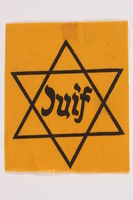
Unused factory-printed Star of David badge printed with Juif, owned by Jacob J. Barosin
Object
Uncut, unused factory-printed Star of David badge acquired by Jacob Barosin, following its issue by German authorities in occupied France on June 7, 1942. In June 1933, Jacob and Sonia Barosin (previously Judey) immigrated illegally to Paris, France, in order to escape the anti-Jewish laws passed following the appointment of Adolf Hitler as chancellor of Germany in January. Jacob voluntarily enlisted in the French military following the 1939 German invasion of Poland. In May1940, Germany invaded France, Jacob and Sonia were arrested as enemy aliens, and Sonia was transported to Gurs internment camp. On June 2, Jacob was transported to Langlade, to serve as a prestataire. Sonia was released from Gurs and traveled to Nice. On May 15, 1941, Jacob was released and moved to Lunel, where Sonia joined him in April 1942. In mid-October, Jacob was sent to Agde internment camp. A friend of his father worked in the camp office and arranged for him to return to Lunel. German forces occupied Lunel in November, so Jacob and Sonia fled to Florac. On February 17, 1943, Jacob was arrested and transported to Gurs, and then sent to a labor camp in Gignac on March 21. Jacob returned to Florac on April 17, and teacher Simone Serriere hid Jacob and Sonia in her schoolhouse in Montmejean. After they were discovered by townspeople, Sonia’s cousins, Boris and Paulette, brought them forged identity papers, and they all returned to Paris in September. Jacob and Sonia were given refuge by Paulette’s mother, until Paris was liberated in late August 1944. The majority of Jacob’s family survived, though his Latvian relatives and his sister, Sina Ida, were murdered during the Holocaust.
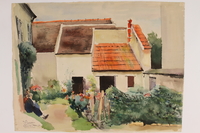
Watercolor painting of a domestic scene by Jacob J. Barosin
Object
Painting by Jacob Barosin, depicting a domestic scene in Villiers-sur-Morin, a suburb of Paris, France. In June 1933, Jacob and Sonia Barosin (previously Judey) immigrated illegally to Paris, France, in order to escape the anti-Jewish laws passed following the appointment of Adolf Hitler as chancellor of Germany in January. Jacob voluntarily enlisted in the French military following the 1939 German invasion of Poland. In May1940, Germany invaded France, Jacob and Sonia were arrested as enemy aliens, and Sonia was transported to Gurs internment camp. On June 2, Jacob was transported to Langlade, to serve as a prestataire. Sonia was released from Gurs and traveled to Nice. On May 15, 1941, Jacob was released and moved to Lunel, where Sonia joined him in April 1942. In mid-October, Jacob was sent to Agde internment camp. A friend of his father worked in the camp office and arranged for him to return to Lunel. German forces occupied Lunel in November, so Jacob and Sonia fled to Florac. On February 17, 1943, Jacob was arrested and transported to Gurs, and then sent to a labor camp in Gignac on March 21. Jacob returned to Florac on April 17, and teacher Simone Serriere hid Jacob and Sonia in her schoolhouse in Montmejean. After they were discovered by townspeople, Sonia’s cousins, Boris and Paulette, brought them forged identity papers, and they all returned to Paris in September. Jacob and Sonia were given refuge by Paulette’s mother, until Paris was liberated in late August 1944. The majority of Jacob’s family survived, though his Latvian relatives and his sister, Sina Ida, were murdered during the Holocaust.
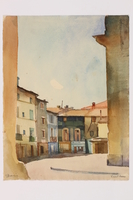
Watercolor painting of a street scene by Jacob J. Barosin
Object
Painting depicting a street in Lunel, France, where Jacob Barosin lived after his release from labor service for the French military in late May 1941 to November 1942. In June 1933, Jacob and Sonia Barosin (previously Judey) immigrated illegally to Paris, France, in order to escape the anti-Jewish laws passed following the appointment of Adolf Hitler as chancellor of Germany in January. Jacob voluntarily enlisted in the French military following the 1939 German invasion of Poland. In May1940, Germany invaded France, Jacob and Sonia were arrested as enemy aliens, and Sonia was transported to Gurs internment camp. On June 2, Jacob was transported to Langlade, to serve as a prestataire. Sonia was released from Gurs and traveled to Nice. On May 15, 1941, Jacob was released and moved to Lunel, where Sonia joined him in April 1942. In mid-October, Jacob was sent to Agde internment camp. A friend of his father worked in the camp office and arranged for him to return to Lunel. German forces occupied Lunel in November, so Jacob and Sonia fled to Florac. On February 17, 1943, Jacob was arrested and transported to Gurs, and then sent to a labor camp in Gignac on March 21. Jacob returned to Florac on April 17, and teacher Simone Serriere hid Jacob and Sonia in her schoolhouse in Montmejean. After they were discovered by townspeople, Sonia’s cousins, Boris and Paulette, brought them forged identity papers, and they all returned to Paris in September. Jacob and Sonia were given refuge by Paulette’s mother, until Paris was liberated in late August 1944. The majority of Jacob’s family survived, though his Latvian relatives and his sister, Sina Ida, were murdered during the Holocaust.
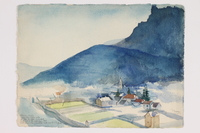
Watercolor painting of a mountain village by Jacob J. Barosin
Object
Unfinished watercolor depicting the mountain village of Florac, painted by Jacob Barosin on February 16, 1943. He had intended to return and finish it, but Jacob was arrested the following morning and transported to Gurs internment camp. In June 1933, Jacob and Sonia Barosin (previously Judey) immigrated illegally to Paris, in order to escape the anti-Jewish laws passed following the appointment of Adolf Hitler as chancellor of Germany in January. Jacob voluntarily enlisted in the French military following the 1939 German invasion of Poland. In May 1940, Germany invaded France, Jacob and Sonia were arrested as enemy aliens, and Sonia was transported to Gurs internment camp. On June 2, Jacob was transported to Langlade, to serve as a prestataire. Sonia was released from Gurs and traveled to Nice. On May 15, 1941, Jacob was released and moved to Lunel, where Sonia joined him in April 1942. In mid-October, Jacob was sent to Agde internment camp. A friend of his father worked in the camp office and arranged for him to return to Lunel. German forces occupied Lunel in November, so Jacob and Sonia fled to Florac. On February 17, 1943, Jacob was arrested and transported to Gurs, and then sent to a labor camp in Gignac on March 21. Jacob returned to Florac on April 17, and teacher Simone Serriere hid Jacob and Sonia in her schoolhouse in Montmejean. After they were discovered by townspeople, Sonia’s cousins, Boris and Paulette, brought them forged identity papers, and they all returned to Paris in September. Jacob and Sonia were given refuge by Paulette’s mother, until Paris was liberated in late August 1944. The majority of Jacob’s family survived, though his Latvian relatives and his sister, Sina Ida, were murdered during the Holocaust.
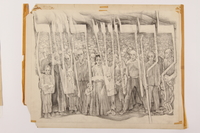
Pencil drawing depicting Holocaust victims by Jacob J. Barosin
Object
Pencil drawing, one of multiple studies for a larger work, depicting concentration camp inmates who were killed, created postwar by Jacob Barosin in the United States. In June 1933, Jacob and Sonia Barosin (previously Judey) immigrated illegally to Paris, in order to escape the anti-Jewish laws passed following the appointment of Adolf Hitler as chancellor of Germany in January. Jacob voluntarily enlisted in the French military following the 1939 German invasion of Poland. In May 1940, Germany invaded France, Jacob and Sonia were arrested as enemy aliens, and Sonia was transported to Gurs internment camp. On June 2, Jacob was transported to Langlade, to serve as a prestataire. Sonia was released from Gurs and traveled to Nice. On May 15, 1941, Jacob was released and moved to Lunel, where Sonia joined him in April 1942. In mid-October, Jacob was sent to Agde internment camp. A friend of his father worked in the camp office and arranged for him to return to Lunel. German forces occupied Lunel in November, so Jacob and Sonia fled to Florac. On February 17, 1943, Jacob was arrested and transported to Gurs, and then sent to a labor camp in Gignac on March 21. Jacob returned to Florac on April 17, and teacher Simone Serriere hid Jacob and Sonia in her schoolhouse in Montmejean. After they were discovered by townspeople, Sonia’s cousins, Boris and Paulette, brought them forged identity papers, and they all returned to Paris in September. Jacob and Sonia were given refuge by Paulette’s mother, until Paris was liberated in late August 1944. The majority of Jacob’s family survived, though his Latvian relatives and his sister, Sina Ida, were murdered during the Holocaust.
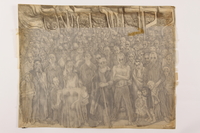
Pencil drawing and overlay depicting Holocaust victims by Jacob J. Barosin
Object
Pencil drawing with a partially completed overlay, one of multiple studies for a larger work, depicting concentration camp inmates who were killed, created postwar by Jacob Barosin in the United States. In June 1933, Jacob and Sonia Barosin (previously Judey) immigrated illegally to Paris, in order to escape the anti-Jewish laws passed following the appointment of Adolf Hitler as chancellor of Germany in January. Jacob voluntarily enlisted in the French military following the 1939 German invasion of Poland. In May 1940, Germany invaded France, Jacob and Sonia were arrested as enemy aliens, and Sonia was transported to Gurs internment camp. On June 2, Jacob was transported to Langlade, to serve as a prestataire. Sonia was released from Gurs and traveled to Nice. On May 15, 1941, Jacob was released and moved to Lunel, where Sonia joined him in April 1942. In mid-October, Jacob was sent to Agde internment camp. A friend of his father worked in the camp office and arranged for him to return to Lunel. German forces occupied Lunel in November, so Jacob and Sonia fled to Florac. On February 17, 1943, Jacob was arrested and transported to Gurs, and then sent to a labor camp in Gignac on March 21. Jacob returned to Florac on April 17, and teacher Simone Serriere hid Jacob and Sonia in her schoolhouse in Montmejean. After they were discovered by townspeople, Sonia’s cousins, Boris and Paulette, brought them forged identity papers, and they all returned to Paris in September. Jacob and Sonia were given refuge by Paulette’s mother, until Paris was liberated in late August 1944. The majority of Jacob’s family survived, though his Latvian relatives and his sister, Sina Ida, were murdered during the Holocaust.
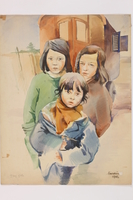
Watercolor portrait of three young girls by Jacob J. Barosin
Object
Watercolor painting depicting three girls, completed by Jacob Barosin in 1942. It was likely completed in the spring near the town of Lunel, where Jacob lived and worked on a nearby farm until German forces occupied the area in November 1942. In June 1933, Jacob and Sonia Barosin (previously Judey) immigrated illegally to Paris, in order to escape the anti-Jewish laws passed following the appointment of Adolf Hitler as chancellor of Germany in January. Jacob voluntarily enlisted in the French military following the 1939 German invasion of Poland. In May 1940, Germany invaded France, Jacob and Sonia were arrested as enemy aliens, and Sonia was transported to Gurs internment camp. On June 2, Jacob was transported to Langlade, to serve as a prestataire. Sonia was released from Gurs and traveled to Nice. On May 15, 1941, Jacob was released and moved to Lunel, where Sonia joined him in April 1942. In mid-October, Jacob was sent to Agde internment camp. A friend of his father worked in the camp office and arranged for him to return to Lunel. German forces occupied Lunel in November, so Jacob and Sonia fled to Florac. On February 17, 1943, Jacob was arrested and transported to Gurs, and then sent to a labor camp in Gignac on March 21. Jacob returned to Florac on April 17, and teacher Simone Serriere hid Jacob and Sonia in her schoolhouse in Montmejean. After they were discovered by townspeople, Sonia’s cousins, Boris and Paulette, brought them forged identity papers, and they all returned to Paris in September. Jacob and Sonia were given refuge by Paulette’s mother, until Paris was liberated in late August 1944. The majority of Jacob’s family survived, though his Latvian relatives and his sister, Sina Ida, were murdered during the Holocaust.
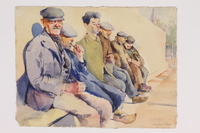
Watercolor painting of a group of men by Jacob J. Barosin
Object
Watercolor painting depicting a group of men outside the hospital in Lunel, France, where Jacob Barosin lived from late May 1941 to November 1942, following his release from labor service for the French military. In June 1933, Jacob and Sonia Barosin (previously Judey) immigrated illegally to Paris, in order to escape the anti-Jewish laws passed following the appointment of Adolf Hitler as chancellor of Germany in January. Jacob voluntarily enlisted in the French military following the 1939 German invasion of Poland. In May 1940, Germany invaded France, Jacob and Sonia were arrested as enemy aliens, and Sonia was transported to Gurs internment camp. On June 2, Jacob was transported to Langlade, to serve as a prestataire. Sonia was released from Gurs and traveled to Nice. On May 15, 1941, Jacob was released and moved to Lunel, where Sonia joined him in April 1942. In mid-October, Jacob was sent to Agde internment camp. A friend of his father worked in the camp office and arranged for him to return to Lunel. German forces occupied Lunel in November, so Jacob and Sonia fled to Florac. On February 17, 1943, Jacob was arrested and transported to Gurs, and then sent to a labor camp in Gignac on March 21. Jacob returned to Florac on April 17, and teacher Simone Serriere hid Jacob and Sonia in her schoolhouse in Montmejean. After they were discovered by townspeople, Sonia’s cousins, Boris and Paulette, brought them forged identity papers, and they all returned to Paris in September. Jacob and Sonia were given refuge by Paulette’s mother, until Paris was liberated in late August 1944. The majority of Jacob’s family survived, though his Latvian relatives and his sister, Sina Ida, were murdered during the Holocaust.
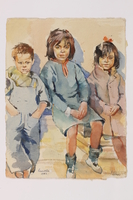
Watercolor painting of three children by Jacob J. Barosin
Object
Watercolor painting depicting three children, created by Jacob Barosin in 1942. It was likely completed in the spring near the town of Lunel, where Jacob lived and worked on a nearby farm until German forces occupied the area in November 1942. In June 1933, Jacob and Sonia Barosin (previously Judey) immigrated illegally to Paris, in order to escape the anti-Jewish laws passed following the appointment of Adolf Hitler as chancellor of Germany in January. Jacob voluntarily enlisted in the French military following the 1939 German invasion of Poland. In May 1940, Germany invaded France, Jacob and Sonia were arrested as enemy aliens, and Sonia was transported to Gurs internment camp. On June 2, Jacob was transported to Langlade, to serve as a prestataire. Sonia was released from Gurs and traveled to Nice. On May 15, 1941, Jacob was released and moved to Lunel, where Sonia joined him in April 1942. In mid-October, Jacob was sent to Agde internment camp. A friend of his father worked in the camp office and arranged for him to return to Lunel. German forces occupied Lunel in November, so Jacob and Sonia fled to Florac. On February 17, 1943, Jacob was arrested and transported to Gurs, and then sent to a labor camp in Gignac on March 21. Jacob returned to Florac on April 17, and teacher Simone Serriere hid Jacob and Sonia in her schoolhouse in Montmejean. After they were discovered by townspeople, Sonia’s cousins, Boris and Paulette, brought them forged identity papers, and they all returned to Paris in September. Jacob and Sonia were given refuge by Paulette’s mother, until Paris was liberated in late August 1944. The majority of Jacob’s family survived, though his Latvian relatives and his sister, Sina Ida, were murdered during the Holocaust.
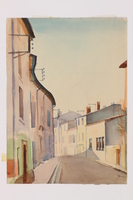
Watercolor painting of a street scene by Jacob J. Barosin
Object
Watercolor painting depicting a street in Lunel, France, where Jacob Barosin lived from late May 1941 to November 1942, following his release from labor service for the French military. In June 1933, Jacob and Sonia Barosin (previously Judey) immigrated illegally to Paris, in order to escape the anti-Jewish laws passed following the appointment of Adolf Hitler as chancellor of Germany in January. Jacob voluntarily enlisted in the French military following the 1939 German invasion of Poland. In May 1940, Germany invaded France, Jacob and Sonia were arrested as enemy aliens, and Sonia was transported to Gurs internment camp. On June 2, Jacob was transported to Langlade, to serve as a prestataire. Sonia was released from Gurs and traveled to Nice. On May 15, 1941, Jacob was released and moved to Lunel, where Sonia joined him in April 1942. In mid-October, Jacob was sent to Agde internment camp. A friend of his father worked in the camp office and arranged for him to return to Lunel. German forces occupied Lunel in November, so Jacob and Sonia fled to Florac. On February 17, 1943, Jacob was arrested and transported to Gurs, and then sent to a labor camp in Gignac on March 21. Jacob returned to Florac on April 17, and teacher Simone Serriere hid Jacob and Sonia in her schoolhouse in Montmejean. After they were discovered by townspeople, Sonia’s cousins, Boris and Paulette, brought them forged identity papers, and they all returned to Paris in September. Jacob and Sonia were given refuge by Paulette’s mother, until Paris was liberated in late August 1944. The majority of Jacob’s family survived, though his Latvian relatives and his sister, Sina Ida, were murdered during the Holocaust.
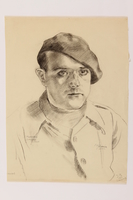
Pencil portrait of a man in a beret by Jacob J. Barosin
Object
Pencil portrait drawn by Jacob Barosin in early 1941 while he was in Langlade. It likely depicts a fellow prestataire, the name given to foreign laborers attached to the French army. In June 1933, Jacob and Sonia Barosin (previously Judey) immigrated illegally to Paris, in order to escape the anti-Jewish laws passed following the appointment of Adolf Hitler as chancellor of Germany in January. Jacob voluntarily enlisted in the French military following the 1939 German invasion of Poland. In May 1940, Germany invaded France, Jacob and Sonia were arrested as enemy aliens, and Sonia was transported to Gurs internment camp. On June 2, Jacob was transported to Langlade, to serve as a prestataire. Sonia was released from Gurs and traveled to Nice. On May 15, 1941, Jacob was released and moved to Lunel, where Sonia joined him in April 1942. In mid-October, Jacob was sent to Agde internment camp. A friend of his father worked in the camp office and arranged for him to return to Lunel. German forces occupied Lunel in November, so Jacob and Sonia fled to Florac. On February 17, 1943, Jacob was arrested and transported to Gurs, and then sent to a labor camp in Gignac on March 21. Jacob returned to Florac on April 17, and teacher Simone Serriere hid Jacob and Sonia in her schoolhouse in Montmejean. After they were discovered by townspeople, Sonia’s cousins, Boris and Paulette, brought them forged identity papers, and they all returned to Paris in September. Jacob and Sonia were given refuge by Paulette’s mother, until Paris was liberated in late August 1944. The majority of Jacob’s family survived, though his Latvian relatives and his sister, Sina Ida, were murdered during the Holocaust.
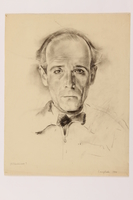
Charcoal drawing
Object
Drawing depicting Jacob Barosin’s experiences while interned or living in hiding in southern France from June 1940 to August 1943. In June 1933, Jacob and Sonia Barosin (previously Judey) immigrated illegally to Paris, France, in order to escape the anti-Jewish laws passed following the appointment of Adolf Hitler as chancellor of Germany in January. Jacob voluntarily enlisted in the French military following the 1939 German invasion of Poland. In May1940, Germany invaded France, Jacob and Sonia were arrested as enemy aliens, and Sonia was transported to Gurs internment camp. On June 2, Jacob was transported to Langlade, to serve as a prestataire. Sonia was released from Gurs and traveled to Nice. On May 15, 1941, Jacob was released and moved to Lunel, where Sonia joined him in April 1942. In mid-October, Jacob was sent to Agde internment camp. A friend of his father worked in the camp office and arranged for him to return to Lunel. German forces occupied Lunel in November, so Jacob and Sonia fled to Florac. On February 17, 1943, Jacob was arrested and transported to Gurs, and then sent to a labor camp in Gignac on March 21. Jacob returned to Florac on April 17, and teacher Simone Serriere hid Jacob and Sonia in her schoolhouse in Montmejean. After they were discovered by townspeople, Sonia’s cousins, Boris and Paulette, brought them forged identity papers, and they all returned to Paris in September. Jacob and Sonia were given refuge by Paulette’s mother, until Paris was liberated in late August 1944. The majority of Jacob’s family survived, though his Latvian relatives and his sister, Sina Ida, were murdered during the Holocaust.
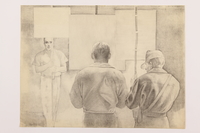
Pencil drawing
Object
Drawing depicting Jacob Barosin’s experiences while interned or living in hiding in southern France from June 1940 to August 1943. In June 1933, Jacob and Sonia Barosin (previously Judey) immigrated illegally to Paris, France, in order to escape the anti-Jewish laws passed following the appointment of Adolf Hitler as chancellor of Germany in January. Jacob voluntarily enlisted in the French military following the 1939 German invasion of Poland. In May1940, Germany invaded France, Jacob and Sonia were arrested as enemy aliens, and Sonia was transported to Gurs internment camp. On June 2, Jacob was transported to Langlade, to serve as a prestataire. Sonia was released from Gurs and traveled to Nice. On May 15, 1941, Jacob was released and moved to Lunel, where Sonia joined him in April 1942. In mid-October, Jacob was sent to Agde internment camp. A friend of his father worked in the camp office and arranged for him to return to Lunel. German forces occupied Lunel in November, so Jacob and Sonia fled to Florac. On February 17, 1943, Jacob was arrested and transported to Gurs, and then sent to a labor camp in Gignac on March 21. Jacob returned to Florac on April 17, and teacher Simone Serriere hid Jacob and Sonia in her schoolhouse in Montmejean. After they were discovered by townspeople, Sonia’s cousins, Boris and Paulette, brought them forged identity papers, and they all returned to Paris in September. Jacob and Sonia were given refuge by Paulette’s mother, until Paris was liberated in late August 1944. The majority of Jacob’s family survived, though his Latvian relatives and his sister, Sina Ida, were murdered during the Holocaust.
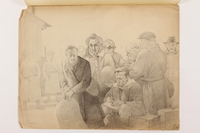
Pencil drawing
Object
Drawing depicting Jacob Barosin’s experiences while interned or living in hiding in southern France from June 1940 to August 1943. In June 1933, Jacob and Sonia Barosin (previously Judey) immigrated illegally to Paris, France, in order to escape the anti-Jewish laws passed following the appointment of Adolf Hitler as chancellor of Germany in January. Jacob voluntarily enlisted in the French military following the 1939 German invasion of Poland. In May1940, Germany invaded France, Jacob and Sonia were arrested as enemy aliens, and Sonia was transported to Gurs internment camp. On June 2, Jacob was transported to Langlade, to serve as a prestataire. Sonia was released from Gurs and traveled to Nice. On May 15, 1941, Jacob was released and moved to Lunel, where Sonia joined him in April 1942. In mid-October, Jacob was sent to Agde internment camp. A friend of his father worked in the camp office and arranged for him to return to Lunel. German forces occupied Lunel in November, so Jacob and Sonia fled to Florac. On February 17, 1943, Jacob was arrested and transported to Gurs, and then sent to a labor camp in Gignac on March 21. Jacob returned to Florac on April 17, and teacher Simone Serriere hid Jacob and Sonia in her schoolhouse in Montmejean. After they were discovered by townspeople, Sonia’s cousins, Boris and Paulette, brought them forged identity papers, and they all returned to Paris in September. Jacob and Sonia were given refuge by Paulette’s mother, until Paris was liberated in late August 1944. The majority of Jacob’s family survived, though his Latvian relatives and his sister, Sina Ida, were murdered during the Holocaust.
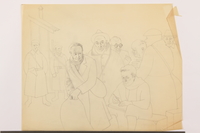
Pencil sketch on vellum
Object
Drawing depicting Jacob Barosin’s experiences while interned or living in hiding in southern France from June 1940 to August 1943. In June 1933, Jacob and Sonia Barosin (previously Judey) immigrated illegally to Paris, France, in order to escape the anti-Jewish laws passed following the appointment of Adolf Hitler as chancellor of Germany in January. Jacob voluntarily enlisted in the French military following the 1939 German invasion of Poland. In May1940, Germany invaded France, Jacob and Sonia were arrested as enemy aliens, and Sonia was transported to Gurs internment camp. On June 2, Jacob was transported to Langlade, to serve as a prestataire. Sonia was released from Gurs and traveled to Nice. On May 15, 1941, Jacob was released and moved to Lunel, where Sonia joined him in April 1942. In mid-October, Jacob was sent to Agde internment camp. A friend of his father worked in the camp office and arranged for him to return to Lunel. German forces occupied Lunel in November, so Jacob and Sonia fled to Florac. On February 17, 1943, Jacob was arrested and transported to Gurs, and then sent to a labor camp in Gignac on March 21. Jacob returned to Florac on April 17, and teacher Simone Serriere hid Jacob and Sonia in her schoolhouse in Montmejean. After they were discovered by townspeople, Sonia’s cousins, Boris and Paulette, brought them forged identity papers, and they all returned to Paris in September. Jacob and Sonia were given refuge by Paulette’s mother, until Paris was liberated in late August 1944. The majority of Jacob’s family survived, though his Latvian relatives and his sister, Sina Ida, were murdered during the Holocaust.
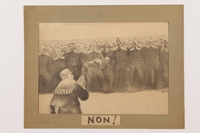
Pencil drawing
Object
Drawing depicting Jacob Barosin’s experiences while interned or living in hiding in southern France from June 1940 to August 1943. In June 1933, Jacob and Sonia Barosin (previously Judey) immigrated illegally to Paris, France, in order to escape the anti-Jewish laws passed following the appointment of Adolf Hitler as chancellor of Germany in January. Jacob voluntarily enlisted in the French military following the 1939 German invasion of Poland. In May1940, Germany invaded France, Jacob and Sonia were arrested as enemy aliens, and Sonia was transported to Gurs internment camp. On June 2, Jacob was transported to Langlade, to serve as a prestataire. Sonia was released from Gurs and traveled to Nice. On May 15, 1941, Jacob was released and moved to Lunel, where Sonia joined him in April 1942. In mid-October, Jacob was sent to Agde internment camp. A friend of his father worked in the camp office and arranged for him to return to Lunel. German forces occupied Lunel in November, so Jacob and Sonia fled to Florac. On February 17, 1943, Jacob was arrested and transported to Gurs, and then sent to a labor camp in Gignac on March 21. Jacob returned to Florac on April 17, and teacher Simone Serriere hid Jacob and Sonia in her schoolhouse in Montmejean. After they were discovered by townspeople, Sonia’s cousins, Boris and Paulette, brought them forged identity papers, and they all returned to Paris in September. Jacob and Sonia were given refuge by Paulette’s mother, until Paris was liberated in late August 1944. The majority of Jacob’s family survived, though his Latvian relatives and his sister, Sina Ida, were murdered during the Holocaust.
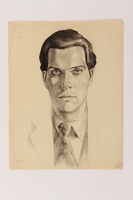
Charcoal drawing
Object
Drawing depicting Jacob Barosin’s experiences while interned or living in hiding in southern France from June 1940 to August 1943. In June 1933, Jacob and Sonia Barosin (previously Judey) immigrated illegally to Paris, France, in order to escape the anti-Jewish laws passed following the appointment of Adolf Hitler as chancellor of Germany in January. Jacob voluntarily enlisted in the French military following the 1939 German invasion of Poland. In May1940, Germany invaded France, Jacob and Sonia were arrested as enemy aliens, and Sonia was transported to Gurs internment camp. On June 2, Jacob was transported to Langlade, to serve as a prestataire. Sonia was released from Gurs and traveled to Nice. On May 15, 1941, Jacob was released and moved to Lunel, where Sonia joined him in April 1942. In mid-October, Jacob was sent to Agde internment camp. A friend of his father worked in the camp office and arranged for him to return to Lunel. German forces occupied Lunel in November, so Jacob and Sonia fled to Florac. On February 17, 1943, Jacob was arrested and transported to Gurs, and then sent to a labor camp in Gignac on March 21. Jacob returned to Florac on April 17, and teacher Simone Serriere hid Jacob and Sonia in her schoolhouse in Montmejean. After they were discovered by townspeople, Sonia’s cousins, Boris and Paulette, brought them forged identity papers, and they all returned to Paris in September. Jacob and Sonia were given refuge by Paulette’s mother, until Paris was liberated in late August 1944. The majority of Jacob’s family survived, though his Latvian relatives and his sister, Sina Ida, were murdered during the Holocaust.
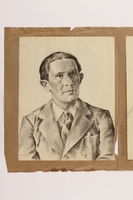
Pencil drawing
Object
Drawing depicting Jacob Barosin’s experiences while interned or living in hiding in southern France from June 1940 to August 1943. In June 1933, Jacob and Sonia Barosin (previously Judey) immigrated illegally to Paris, France, in order to escape the anti-Jewish laws passed following the appointment of Adolf Hitler as chancellor of Germany in January. Jacob voluntarily enlisted in the French military following the 1939 German invasion of Poland. In May1940, Germany invaded France, Jacob and Sonia were arrested as enemy aliens, and Sonia was transported to Gurs internment camp. On June 2, Jacob was transported to Langlade, to serve as a prestataire. Sonia was released from Gurs and traveled to Nice. On May 15, 1941, Jacob was released and moved to Lunel, where Sonia joined him in April 1942. In mid-October, Jacob was sent to Agde internment camp. A friend of his father worked in the camp office and arranged for him to return to Lunel. German forces occupied Lunel in November, so Jacob and Sonia fled to Florac. On February 17, 1943, Jacob was arrested and transported to Gurs, and then sent to a labor camp in Gignac on March 21. Jacob returned to Florac on April 17, and teacher Simone Serriere hid Jacob and Sonia in her schoolhouse in Montmejean. After they were discovered by townspeople, Sonia’s cousins, Boris and Paulette, brought them forged identity papers, and they all returned to Paris in September. Jacob and Sonia were given refuge by Paulette’s mother, until Paris was liberated in late August 1944. The majority of Jacob’s family survived, though his Latvian relatives and his sister, Sina Ida, were murdered during the Holocaust.
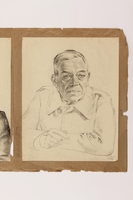
Pencil drawing
Object
Drawing depicting Jacob Barosin’s experiences while interned or living in hiding in southern France from June 1940 to August 1943. In June 1933, Jacob and Sonia Barosin (previously Judey) immigrated illegally to Paris, France, in order to escape the anti-Jewish laws passed following the appointment of Adolf Hitler as chancellor of Germany in January. Jacob voluntarily enlisted in the French military following the 1939 German invasion of Poland. In May1940, Germany invaded France, Jacob and Sonia were arrested as enemy aliens, and Sonia was transported to Gurs internment camp. On June 2, Jacob was transported to Langlade, to serve as a prestataire. Sonia was released from Gurs and traveled to Nice. On May 15, 1941, Jacob was released and moved to Lunel, where Sonia joined him in April 1942. In mid-October, Jacob was sent to Agde internment camp. A friend of his father worked in the camp office and arranged for him to return to Lunel. German forces occupied Lunel in November, so Jacob and Sonia fled to Florac. On February 17, 1943, Jacob was arrested and transported to Gurs, and then sent to a labor camp in Gignac on March 21. Jacob returned to Florac on April 17, and teacher Simone Serriere hid Jacob and Sonia in her schoolhouse in Montmejean. After they were discovered by townspeople, Sonia’s cousins, Boris and Paulette, brought them forged identity papers, and they all returned to Paris in September. Jacob and Sonia were given refuge by Paulette’s mother, until Paris was liberated in late August 1944. The majority of Jacob’s family survived, though his Latvian relatives and his sister, Sina Ida, were murdered during the Holocaust.
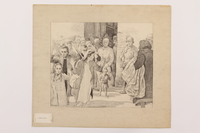
Pencil drawing
Object
Drawing depicting Jacob Barosin’s experiences while interned or living in hiding in southern France from June 1940 to August 1943. In June 1933, Jacob and Sonia Barosin (previously Judey) immigrated illegally to Paris, France, in order to escape the anti-Jewish laws passed following the appointment of Adolf Hitler as chancellor of Germany in January. Jacob voluntarily enlisted in the French military following the 1939 German invasion of Poland. In May1940, Germany invaded France, Jacob and Sonia were arrested as enemy aliens, and Sonia was transported to Gurs internment camp. On June 2, Jacob was transported to Langlade, to serve as a prestataire. Sonia was released from Gurs and traveled to Nice. On May 15, 1941, Jacob was released and moved to Lunel, where Sonia joined him in April 1942. In mid-October, Jacob was sent to Agde internment camp. A friend of his father worked in the camp office and arranged for him to return to Lunel. German forces occupied Lunel in November, so Jacob and Sonia fled to Florac. On February 17, 1943, Jacob was arrested and transported to Gurs, and then sent to a labor camp in Gignac on March 21. Jacob returned to Florac on April 17, and teacher Simone Serriere hid Jacob and Sonia in her schoolhouse in Montmejean. After they were discovered by townspeople, Sonia’s cousins, Boris and Paulette, brought them forged identity papers, and they all returned to Paris in September. Jacob and Sonia were given refuge by Paulette’s mother, until Paris was liberated in late August 1944. The majority of Jacob’s family survived, though his Latvian relatives and his sister, Sina Ida, were murdered during the Holocaust.
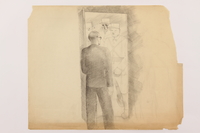
Pencil sketch
Object
Drawing depicting Jacob Barosin’s experiences while interned or living in hiding in southern France from June 1940 to August 1943. In June 1933, Jacob and Sonia Barosin (previously Judey) immigrated illegally to Paris, France, in order to escape the anti-Jewish laws passed following the appointment of Adolf Hitler as chancellor of Germany in January. Jacob voluntarily enlisted in the French military following the 1939 German invasion of Poland. In May1940, Germany invaded France, Jacob and Sonia were arrested as enemy aliens, and Sonia was transported to Gurs internment camp. On June 2, Jacob was transported to Langlade, to serve as a prestataire. Sonia was released from Gurs and traveled to Nice. On May 15, 1941, Jacob was released and moved to Lunel, where Sonia joined him in April 1942. In mid-October, Jacob was sent to Agde internment camp. A friend of his father worked in the camp office and arranged for him to return to Lunel. German forces occupied Lunel in November, so Jacob and Sonia fled to Florac. On February 17, 1943, Jacob was arrested and transported to Gurs, and then sent to a labor camp in Gignac on March 21. Jacob returned to Florac on April 17, and teacher Simone Serriere hid Jacob and Sonia in her schoolhouse in Montmejean. After they were discovered by townspeople, Sonia’s cousins, Boris and Paulette, brought them forged identity papers, and they all returned to Paris in September. Jacob and Sonia were given refuge by Paulette’s mother, until Paris was liberated in late August 1944. The majority of Jacob’s family survived, though his Latvian relatives and his sister, Sina Ida, were murdered during the Holocaust.
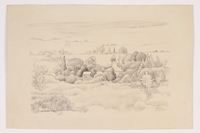
Pencil drawing
Object
Drawing depicting Jacob Barosin’s experiences while interned or living in hiding in southern France from June 1940 to August 1943. In June 1933, Jacob and Sonia Barosin (previously Judey) immigrated illegally to Paris, France, in order to escape the anti-Jewish laws passed following the appointment of Adolf Hitler as chancellor of Germany in January. Jacob voluntarily enlisted in the French military following the 1939 German invasion of Poland. In May1940, Germany invaded France, Jacob and Sonia were arrested as enemy aliens, and Sonia was transported to Gurs internment camp. On June 2, Jacob was transported to Langlade, to serve as a prestataire. Sonia was released from Gurs and traveled to Nice. On May 15, 1941, Jacob was released and moved to Lunel, where Sonia joined him in April 1942. In mid-October, Jacob was sent to Agde internment camp. A friend of his father worked in the camp office and arranged for him to return to Lunel. German forces occupied Lunel in November, so Jacob and Sonia fled to Florac. On February 17, 1943, Jacob was arrested and transported to Gurs, and then sent to a labor camp in Gignac on March 21. Jacob returned to Florac on April 17, and teacher Simone Serriere hid Jacob and Sonia in her schoolhouse in Montmejean. After they were discovered by townspeople, Sonia’s cousins, Boris and Paulette, brought them forged identity papers, and they all returned to Paris in September. Jacob and Sonia were given refuge by Paulette’s mother, until Paris was liberated in late August 1944. The majority of Jacob’s family survived, though his Latvian relatives and his sister, Sina Ida, were murdered during the Holocaust.
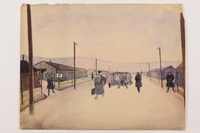
Watercolor
Object
Painting depicting Jacob Barosin’s experiences while interned or living in hiding in southern France from June 1940 to August 1943. In June 1933, Jacob and Sonia Barosin (previously Judey) immigrated illegally to Paris, France, in order to escape the anti-Jewish laws passed following the appointment of Adolf Hitler as chancellor of Germany in January. Jacob voluntarily enlisted in the French military following the 1939 German invasion of Poland. In May1940, Germany invaded France, Jacob and Sonia were arrested as enemy aliens, and Sonia was transported to Gurs internment camp. On June 2, Jacob was transported to Langlade, to serve as a prestataire. Sonia was released from Gurs and traveled to Nice. On May 15, 1941, Jacob was released and moved to Lunel, where Sonia joined him in April 1942. In mid-October, Jacob was sent to Agde internment camp. A friend of his father worked in the camp office and arranged for him to return to Lunel. German forces occupied Lunel in November, so Jacob and Sonia fled to Florac. On February 17, 1943, Jacob was arrested and transported to Gurs, and then sent to a labor camp in Gignac on March 21. Jacob returned to Florac on April 17, and teacher Simone Serriere hid Jacob and Sonia in her schoolhouse in Montmejean. After they were discovered by townspeople, Sonia’s cousins, Boris and Paulette, brought them forged identity papers, and they all returned to Paris in September. Jacob and Sonia were given refuge by Paulette’s mother, until Paris was liberated in late August 1944. The majority of Jacob’s family survived, though his Latvian relatives and his sister, Sina Ida, were murdered during the Holocaust.
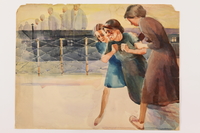
Watercolor
Object
Painting depicting Jacob Barosin’s experiences while interned or living in hiding in southern France from June 1940 to August 1943. In June 1933, Jacob and Sonia Barosin (previously Judey) immigrated illegally to Paris, France, in order to escape the anti-Jewish laws passed following the appointment of Adolf Hitler as chancellor of Germany in January. Jacob voluntarily enlisted in the French military following the 1939 German invasion of Poland. In May1940, Germany invaded France, Jacob and Sonia were arrested as enemy aliens, and Sonia was transported to Gurs internment camp. On June 2, Jacob was transported to Langlade, to serve as a prestataire. Sonia was released from Gurs and traveled to Nice. On May 15, 1941, Jacob was released and moved to Lunel, where Sonia joined him in April 1942. In mid-October, Jacob was sent to Agde internment camp. A friend of his father worked in the camp office and arranged for him to return to Lunel. German forces occupied Lunel in November, so Jacob and Sonia fled to Florac. On February 17, 1943, Jacob was arrested and transported to Gurs, and then sent to a labor camp in Gignac on March 21. Jacob returned to Florac on April 17, and teacher Simone Serriere hid Jacob and Sonia in her schoolhouse in Montmejean. After they were discovered by townspeople, Sonia’s cousins, Boris and Paulette, brought them forged identity papers, and they all returned to Paris in September. Jacob and Sonia were given refuge by Paulette’s mother, until Paris was liberated in late August 1944. The majority of Jacob’s family survived, though his Latvian relatives and his sister, Sina Ida, were murdered during the Holocaust.
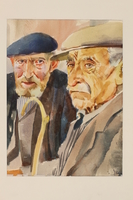
Watercolor painting
Object
Painting depicting Jacob Barosin’s experiences while interned or living in hiding in southern France from June 1940 to August 1943. In June 1933, Jacob and Sonia Barosin (previously Judey) immigrated illegally to Paris, France, in order to escape the anti-Jewish laws passed following the appointment of Adolf Hitler as chancellor of Germany in January. Jacob voluntarily enlisted in the French military following the 1939 German invasion of Poland. In May1940, Germany invaded France, Jacob and Sonia were arrested as enemy aliens, and Sonia was transported to Gurs internment camp. On June 2, Jacob was transported to Langlade, to serve as a prestataire. Sonia was released from Gurs and traveled to Nice. On May 15, 1941, Jacob was released and moved to Lunel, where Sonia joined him in April 1942. In mid-October, Jacob was sent to Agde internment camp. A friend of his father worked in the camp office and arranged for him to return to Lunel. German forces occupied Lunel in November, so Jacob and Sonia fled to Florac. On February 17, 1943, Jacob was arrested and transported to Gurs, and then sent to a labor camp in Gignac on March 21. Jacob returned to Florac on April 17, and teacher Simone Serriere hid Jacob and Sonia in her schoolhouse in Montmejean. After they were discovered by townspeople, Sonia’s cousins, Boris and Paulette, brought them forged identity papers, and they all returned to Paris in September. Jacob and Sonia were given refuge by Paulette’s mother, until Paris was liberated in late August 1944. The majority of Jacob’s family survived, though his Latvian relatives and his sister, Sina Ida, were murdered during the Holocaust.
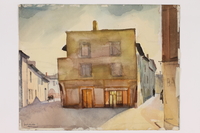
Watercolor painting
Object
Painting depicting Jacob Barosin’s experiences while interned or living in hiding in southern France from June 1940 to August 1943. In June 1933, Jacob and Sonia Barosin (previously Judey) immigrated illegally to Paris, France, in order to escape the anti-Jewish laws passed following the appointment of Adolf Hitler as chancellor of Germany in January. Jacob voluntarily enlisted in the French military following the 1939 German invasion of Poland. In May1940, Germany invaded France, Jacob and Sonia were arrested as enemy aliens, and Sonia was transported to Gurs internment camp. On June 2, Jacob was transported to Langlade, to serve as a prestataire. Sonia was released from Gurs and traveled to Nice. On May 15, 1941, Jacob was released and moved to Lunel, where Sonia joined him in April 1942. In mid-October, Jacob was sent to Agde internment camp. A friend of his father worked in the camp office and arranged for him to return to Lunel. German forces occupied Lunel in November, so Jacob and Sonia fled to Florac. On February 17, 1943, Jacob was arrested and transported to Gurs, and then sent to a labor camp in Gignac on March 21. Jacob returned to Florac on April 17, and teacher Simone Serriere hid Jacob and Sonia in her schoolhouse in Montmejean. After they were discovered by townspeople, Sonia’s cousins, Boris and Paulette, brought them forged identity papers, and they all returned to Paris in September. Jacob and Sonia were given refuge by Paulette’s mother, until Paris was liberated in late August 1944. The majority of Jacob’s family survived, though his Latvian relatives and his sister, Sina Ida, were murdered during the Holocaust.
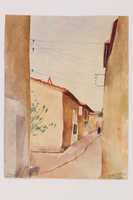
Watercolor painting
Object
Painting depicting Jacob Barosin’s experiences while interned or living in hiding in southern France from June 1940 to August 1943. In June 1933, Jacob and Sonia Barosin (previously Judey) immigrated illegally to Paris, France, in order to escape the anti-Jewish laws passed following the appointment of Adolf Hitler as chancellor of Germany in January. Jacob voluntarily enlisted in the French military following the 1939 German invasion of Poland. In May1940, Germany invaded France, Jacob and Sonia were arrested as enemy aliens, and Sonia was transported to Gurs internment camp. On June 2, Jacob was transported to Langlade, to serve as a prestataire. Sonia was released from Gurs and traveled to Nice. On May 15, 1941, Jacob was released and moved to Lunel, where Sonia joined him in April 1942. In mid-October, Jacob was sent to Agde internment camp. A friend of his father worked in the camp office and arranged for him to return to Lunel. German forces occupied Lunel in November, so Jacob and Sonia fled to Florac. On February 17, 1943, Jacob was arrested and transported to Gurs, and then sent to a labor camp in Gignac on March 21. Jacob returned to Florac on April 17, and teacher Simone Serriere hid Jacob and Sonia in her schoolhouse in Montmejean. After they were discovered by townspeople, Sonia’s cousins, Boris and Paulette, brought them forged identity papers, and they all returned to Paris in September. Jacob and Sonia were given refuge by Paulette’s mother, until Paris was liberated in late August 1944. The majority of Jacob’s family survived, though his Latvian relatives and his sister, Sina Ida, were murdered during the Holocaust.
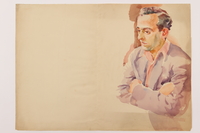
Watercolor portrait
Object
Painting depicting Jacob Barosin’s experiences while interned or living in hiding in southern France from June 1940 to August 1943. In June 1933, Jacob and Sonia Barosin (previously Judey) immigrated illegally to Paris, France, in order to escape the anti-Jewish laws passed following the appointment of Adolf Hitler as chancellor of Germany in January. Jacob voluntarily enlisted in the French military following the 1939 German invasion of Poland. In May1940, Germany invaded France, Jacob and Sonia were arrested as enemy aliens, and Sonia was transported to Gurs internment camp. On June 2, Jacob was transported to Langlade, to serve as a prestataire. Sonia was released from Gurs and traveled to Nice. On May 15, 1941, Jacob was released and moved to Lunel, where Sonia joined him in April 1942. In mid-October, Jacob was sent to Agde internment camp. A friend of his father worked in the camp office and arranged for him to return to Lunel. German forces occupied Lunel in November, so Jacob and Sonia fled to Florac. On February 17, 1943, Jacob was arrested and transported to Gurs, and then sent to a labor camp in Gignac on March 21. Jacob returned to Florac on April 17, and teacher Simone Serriere hid Jacob and Sonia in her schoolhouse in Montmejean. After they were discovered by townspeople, Sonia’s cousins, Boris and Paulette, brought them forged identity papers, and they all returned to Paris in September. Jacob and Sonia were given refuge by Paulette’s mother, until Paris was liberated in late August 1944. The majority of Jacob’s family survived, though his Latvian relatives and his sister, Sina Ida, were murdered during the Holocaust.
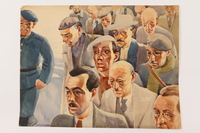
Watercolor portrait
Object
Painting depicting Jacob Barosin’s experiences while interned or living in hiding in southern France from June 1940 to August 1943. In June 1933, Jacob and Sonia Barosin (previously Judey) immigrated illegally to Paris, France, in order to escape the anti-Jewish laws passed following the appointment of Adolf Hitler as chancellor of Germany in January. Jacob voluntarily enlisted in the French military following the 1939 German invasion of Poland. In May1940, Germany invaded France, Jacob and Sonia were arrested as enemy aliens, and Sonia was transported to Gurs internment camp. On June 2, Jacob was transported to Langlade, to serve as a prestataire. Sonia was released from Gurs and traveled to Nice. On May 15, 1941, Jacob was released and moved to Lunel, where Sonia joined him in April 1942. In mid-October, Jacob was sent to Agde internment camp. A friend of his father worked in the camp office and arranged for him to return to Lunel. German forces occupied Lunel in November, so Jacob and Sonia fled to Florac. On February 17, 1943, Jacob was arrested and transported to Gurs, and then sent to a labor camp in Gignac on March 21. Jacob returned to Florac on April 17, and teacher Simone Serriere hid Jacob and Sonia in her schoolhouse in Montmejean. After they were discovered by townspeople, Sonia’s cousins, Boris and Paulette, brought them forged identity papers, and they all returned to Paris in September. Jacob and Sonia were given refuge by Paulette’s mother, until Paris was liberated in late August 1944. The majority of Jacob’s family survived, though his Latvian relatives and his sister, Sina Ida, were murdered during the Holocaust.
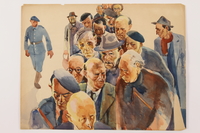
Watercolor portrait
Object
Painting depicting Jacob Barosin’s experiences while interned or living in hiding in southern France from June 1940 to August 1943. In June 1933, Jacob and Sonia Barosin (previously Judey) immigrated illegally to Paris, France, in order to escape the anti-Jewish laws passed following the appointment of Adolf Hitler as chancellor of Germany in January. Jacob voluntarily enlisted in the French military following the 1939 German invasion of Poland. In May1940, Germany invaded France, Jacob and Sonia were arrested as enemy aliens, and Sonia was transported to Gurs internment camp. On June 2, Jacob was transported to Langlade, to serve as a prestataire. Sonia was released from Gurs and traveled to Nice. On May 15, 1941, Jacob was released and moved to Lunel, where Sonia joined him in April 1942. In mid-October, Jacob was sent to Agde internment camp. A friend of his father worked in the camp office and arranged for him to return to Lunel. German forces occupied Lunel in November, so Jacob and Sonia fled to Florac. On February 17, 1943, Jacob was arrested and transported to Gurs, and then sent to a labor camp in Gignac on March 21. Jacob returned to Florac on April 17, and teacher Simone Serriere hid Jacob and Sonia in her schoolhouse in Montmejean. After they were discovered by townspeople, Sonia’s cousins, Boris and Paulette, brought them forged identity papers, and they all returned to Paris in September. Jacob and Sonia were given refuge by Paulette’s mother, until Paris was liberated in late August 1944. The majority of Jacob’s family survived, though his Latvian relatives and his sister, Sina Ida, were murdered during the Holocaust.
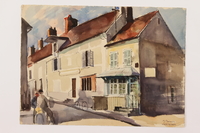
Watercolor portrait
Object
Painting depicting Jacob Barosin’s experiences while interned or living in hiding in southern France from June 1940 to August 1943. In June 1933, Jacob and Sonia Barosin (previously Judey) immigrated illegally to Paris, France, in order to escape the anti-Jewish laws passed following the appointment of Adolf Hitler as chancellor of Germany in January. Jacob voluntarily enlisted in the French military following the 1939 German invasion of Poland. In May1940, Germany invaded France, Jacob and Sonia were arrested as enemy aliens, and Sonia was transported to Gurs internment camp. On June 2, Jacob was transported to Langlade, to serve as a prestataire. Sonia was released from Gurs and traveled to Nice. On May 15, 1941, Jacob was released and moved to Lunel, where Sonia joined him in April 1942. In mid-October, Jacob was sent to Agde internment camp. A friend of his father worked in the camp office and arranged for him to return to Lunel. German forces occupied Lunel in November, so Jacob and Sonia fled to Florac. On February 17, 1943, Jacob was arrested and transported to Gurs, and then sent to a labor camp in Gignac on March 21. Jacob returned to Florac on April 17, and teacher Simone Serriere hid Jacob and Sonia in her schoolhouse in Montmejean. After they were discovered by townspeople, Sonia’s cousins, Boris and Paulette, brought them forged identity papers, and they all returned to Paris in September. Jacob and Sonia were given refuge by Paulette’s mother, until Paris was liberated in late August 1944. The majority of Jacob’s family survived, though his Latvian relatives and his sister, Sina Ida, were murdered during the Holocaust.
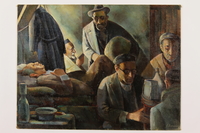
Painting
Object
Painting depicting Jacob Barosin’s experiences while interned or living in hiding in southern France from June 1940 to August 1943. In June 1933, Jacob and Sonia Barosin (previously Judey) immigrated illegally to Paris, France, in order to escape the anti-Jewish laws passed following the appointment of Adolf Hitler as chancellor of Germany in January. Jacob voluntarily enlisted in the French military following the 1939 German invasion of Poland. In May1940, Germany invaded France, Jacob and Sonia were arrested as enemy aliens, and Sonia was transported to Gurs internment camp. On June 2, Jacob was transported to Langlade, to serve as a prestataire. Sonia was released from Gurs and traveled to Nice. On May 15, 1941, Jacob was released and moved to Lunel, where Sonia joined him in April 1942. In mid-October, Jacob was sent to Agde internment camp. A friend of his father worked in the camp office and arranged for him to return to Lunel. German forces occupied Lunel in November, so Jacob and Sonia fled to Florac. On February 17, 1943, Jacob was arrested and transported to Gurs, and then sent to a labor camp in Gignac on March 21. Jacob returned to Florac on April 17, and teacher Simone Serriere hid Jacob and Sonia in her schoolhouse in Montmejean. After they were discovered by townspeople, Sonia’s cousins, Boris and Paulette, brought them forged identity papers, and they all returned to Paris in September. Jacob and Sonia were given refuge by Paulette’s mother, until Paris was liberated in late August 1944. The majority of Jacob’s family survived, though his Latvian relatives and his sister, Sina Ida, were murdered during the Holocaust.
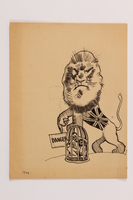
Pencil and ink drawing
Object
Drawing depicting Jacob Barosin’s experiences while interned or living in hiding in southern France from June 1940 to August 1943. In June 1933, Jacob and Sonia Barosin (previously Judey) immigrated illegally to Paris, France, in order to escape the anti-Jewish laws passed following the appointment of Adolf Hitler as chancellor of Germany in January. Jacob voluntarily enlisted in the French military following the 1939 German invasion of Poland. In May1940, Germany invaded France, Jacob and Sonia were arrested as enemy aliens, and Sonia was transported to Gurs internment camp. On June 2, Jacob was transported to Langlade, to serve as a prestataire. Sonia was released from Gurs and traveled to Nice. On May 15, 1941, Jacob was released and moved to Lunel, where Sonia joined him in April 1942. In mid-October, Jacob was sent to Agde internment camp. A friend of his father worked in the camp office and arranged for him to return to Lunel. German forces occupied Lunel in November, so Jacob and Sonia fled to Florac. On February 17, 1943, Jacob was arrested and transported to Gurs, and then sent to a labor camp in Gignac on March 21. Jacob returned to Florac on April 17, and teacher Simone Serriere hid Jacob and Sonia in her schoolhouse in Montmejean. After they were discovered by townspeople, Sonia’s cousins, Boris and Paulette, brought them forged identity papers, and they all returned to Paris in September. Jacob and Sonia were given refuge by Paulette’s mother, until Paris was liberated in late August 1944. The majority of Jacob’s family survived, though his Latvian relatives and his sister, Sina Ida, were murdered during the Holocaust.
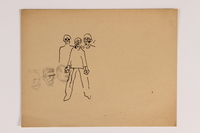
Ink and pencil sketch
Object
Drawing depicting Jacob Barosin’s experiences while interned or living in hiding in southern France from June 1940 to August 1943. In June 1933, Jacob and Sonia Barosin (previously Judey) immigrated illegally to Paris, France, in order to escape the anti-Jewish laws passed following the appointment of Adolf Hitler as chancellor of Germany in January. Jacob voluntarily enlisted in the French military following the 1939 German invasion of Poland. In May1940, Germany invaded France, Jacob and Sonia were arrested as enemy aliens, and Sonia was transported to Gurs internment camp. On June 2, Jacob was transported to Langlade, to serve as a prestataire. Sonia was released from Gurs and traveled to Nice. On May 15, 1941, Jacob was released and moved to Lunel, where Sonia joined him in April 1942. In mid-October, Jacob was sent to Agde internment camp. A friend of his father worked in the camp office and arranged for him to return to Lunel. German forces occupied Lunel in November, so Jacob and Sonia fled to Florac. On February 17, 1943, Jacob was arrested and transported to Gurs, and then sent to a labor camp in Gignac on March 21. Jacob returned to Florac on April 17, and teacher Simone Serriere hid Jacob and Sonia in her schoolhouse in Montmejean. After they were discovered by townspeople, Sonia’s cousins, Boris and Paulette, brought them forged identity papers, and they all returned to Paris in September. Jacob and Sonia were given refuge by Paulette’s mother, until Paris was liberated in late August 1944. The majority of Jacob’s family survived, though his Latvian relatives and his sister, Sina Ida, were murdered during the Holocaust.
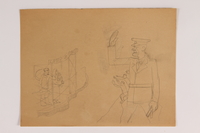
Pencil sketch
Object
Drawing depicting Jacob Barosin’s experiences while interned or living in hiding in southern France from June 1940 to August 1943. In June 1933, Jacob and Sonia Barosin (previously Judey) immigrated illegally to Paris, France, in order to escape the anti-Jewish laws passed following the appointment of Adolf Hitler as chancellor of Germany in January. Jacob voluntarily enlisted in the French military following the 1939 German invasion of Poland. In May1940, Germany invaded France, Jacob and Sonia were arrested as enemy aliens, and Sonia was transported to Gurs internment camp. On June 2, Jacob was transported to Langlade, to serve as a prestataire. Sonia was released from Gurs and traveled to Nice. On May 15, 1941, Jacob was released and moved to Lunel, where Sonia joined him in April 1942. In mid-October, Jacob was sent to Agde internment camp. A friend of his father worked in the camp office and arranged for him to return to Lunel. German forces occupied Lunel in November, so Jacob and Sonia fled to Florac. On February 17, 1943, Jacob was arrested and transported to Gurs, and then sent to a labor camp in Gignac on March 21. Jacob returned to Florac on April 17, and teacher Simone Serriere hid Jacob and Sonia in her schoolhouse in Montmejean. After they were discovered by townspeople, Sonia’s cousins, Boris and Paulette, brought them forged identity papers, and they all returned to Paris in September. Jacob and Sonia were given refuge by Paulette’s mother, until Paris was liberated in late August 1944. The majority of Jacob’s family survived, though his Latvian relatives and his sister, Sina Ida, were murdered during the Holocaust.
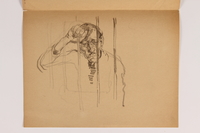
Pencil sketch
Object
Drawing depicting Jacob Barosin’s experiences while interned or living in hiding in southern France from June 1940 to August 1943. In June 1933, Jacob and Sonia Barosin (previously Judey) immigrated illegally to Paris, France, in order to escape the anti-Jewish laws passed following the appointment of Adolf Hitler as chancellor of Germany in January. Jacob voluntarily enlisted in the French military following the 1939 German invasion of Poland. In May1940, Germany invaded France, Jacob and Sonia were arrested as enemy aliens, and Sonia was transported to Gurs internment camp. On June 2, Jacob was transported to Langlade, to serve as a prestataire. Sonia was released from Gurs and traveled to Nice. On May 15, 1941, Jacob was released and moved to Lunel, where Sonia joined him in April 1942. In mid-October, Jacob was sent to Agde internment camp. A friend of his father worked in the camp office and arranged for him to return to Lunel. German forces occupied Lunel in November, so Jacob and Sonia fled to Florac. On February 17, 1943, Jacob was arrested and transported to Gurs, and then sent to a labor camp in Gignac on March 21. Jacob returned to Florac on April 17, and teacher Simone Serriere hid Jacob and Sonia in her schoolhouse in Montmejean. After they were discovered by townspeople, Sonia’s cousins, Boris and Paulette, brought them forged identity papers, and they all returned to Paris in September. Jacob and Sonia were given refuge by Paulette’s mother, until Paris was liberated in late August 1944. The majority of Jacob’s family survived, though his Latvian relatives and his sister, Sina Ida, were murdered during the Holocaust.
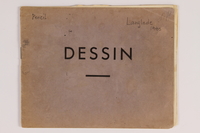
Notebook titled "Dessin"
Object
Sketchbook depicting Jacob Barosin’s experiences while interned or living in hiding in southern France from June 1940 to August 1943. In June 1933, Jacob and Sonia Barosin (previously Judey) immigrated illegally to Paris, France, in order to escape the anti-Jewish laws passed following the appointment of Adolf Hitler as chancellor of Germany in January. Jacob voluntarily enlisted in the French military following the 1939 German invasion of Poland. In May1940, Germany invaded France, Jacob and Sonia were arrested as enemy aliens, and Sonia was transported to Gurs internment camp. On June 2, Jacob was transported to Langlade, to serve as a prestataire. Sonia was released from Gurs and traveled to Nice. On May 15, 1941, Jacob was released and moved to Lunel, where Sonia joined him in April 1942. In mid-October, Jacob was sent to Agde internment camp. A friend of his father worked in the camp office and arranged for him to return to Lunel. German forces occupied Lunel in November, so Jacob and Sonia fled to Florac. On February 17, 1943, Jacob was arrested and transported to Gurs, and then sent to a labor camp in Gignac on March 21. Jacob returned to Florac on April 17, and teacher Simone Serriere hid Jacob and Sonia in her schoolhouse in Montmejean. After they were discovered by townspeople, Sonia’s cousins, Boris and Paulette, brought them forged identity papers, and they all returned to Paris in September. Jacob and Sonia were given refuge by Paulette’s mother, until Paris was liberated in late August 1944. The majority of Jacob’s family survived, though his Latvian relatives and his sister, Sina Ida, were murdered during the Holocaust.
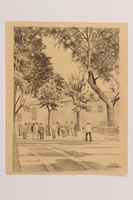
Pencil drawing
Object
Drawing depicting Jacob Barosin’s experiences while interned or living in hiding in southern France from June 1940 to August 1943. In June 1933, Jacob and Sonia Barosin (previously Judey) immigrated illegally to Paris, France, in order to escape the anti-Jewish laws passed following the appointment of Adolf Hitler as chancellor of Germany in January. Jacob voluntarily enlisted in the French military following the 1939 German invasion of Poland. In May1940, Germany invaded France, Jacob and Sonia were arrested as enemy aliens, and Sonia was transported to Gurs internment camp. On June 2, Jacob was transported to Langlade, to serve as a prestataire. Sonia was released from Gurs and traveled to Nice. On May 15, 1941, Jacob was released and moved to Lunel, where Sonia joined him in April 1942. In mid-October, Jacob was sent to Agde internment camp. A friend of his father worked in the camp office and arranged for him to return to Lunel. German forces occupied Lunel in November, so Jacob and Sonia fled to Florac. On February 17, 1943, Jacob was arrested and transported to Gurs, and then sent to a labor camp in Gignac on March 21. Jacob returned to Florac on April 17, and teacher Simone Serriere hid Jacob and Sonia in her schoolhouse in Montmejean. After they were discovered by townspeople, Sonia’s cousins, Boris and Paulette, brought them forged identity papers, and they all returned to Paris in September. Jacob and Sonia were given refuge by Paulette’s mother, until Paris was liberated in late August 1944. The majority of Jacob’s family survived, though his Latvian relatives and his sister, Sina Ida, were murdered during the Holocaust.
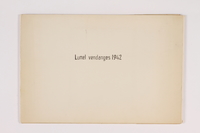
Portfolio cover, "Lunel Vendages 1942"
Object
Portfolio cover depicting Jacob Barosin’s experiences while interned or living in hiding in southern France from June 1940 to August 1943. In June 1933, Jacob and Sonia Barosin (previously Judey) immigrated illegally to Paris, France, in order to escape the anti-Jewish laws passed following the appointment of Adolf Hitler as chancellor of Germany in January. Jacob voluntarily enlisted in the French military following the 1939 German invasion of Poland. In May1940, Germany invaded France, Jacob and Sonia were arrested as enemy aliens, and Sonia was transported to Gurs internment camp. On June 2, Jacob was transported to Langlade, to serve as a prestataire. Sonia was released from Gurs and traveled to Nice. On May 15, 1941, Jacob was released and moved to Lunel, where Sonia joined him in April 1942. In mid-October, Jacob was sent to Agde internment camp. A friend of his father worked in the camp office and arranged for him to return to Lunel. German forces occupied Lunel in November, so Jacob and Sonia fled to Florac. On February 17, 1943, Jacob was arrested and transported to Gurs, and then sent to a labor camp in Gignac on March 21. Jacob returned to Florac on April 17, and teacher Simone Serriere hid Jacob and Sonia in her schoolhouse in Montmejean. After they were discovered by townspeople, Sonia’s cousins, Boris and Paulette, brought them forged identity papers, and they all returned to Paris in September. Jacob and Sonia were given refuge by Paulette’s mother, until Paris was liberated in late August 1944. The majority of Jacob’s family survived, though his Latvian relatives and his sister, Sina Ida, were murdered during the Holocaust.
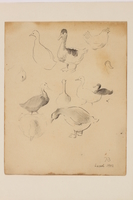
Sketch
Object
Drawing depicting Jacob Barosin’s experiences while interned or living in hiding in southern France from June 1940 to August 1943. In June 1933, Jacob and Sonia Barosin (previously Judey) immigrated illegally to Paris, France, in order to escape the anti-Jewish laws passed following the appointment of Adolf Hitler as chancellor of Germany in January. Jacob voluntarily enlisted in the French military following the 1939 German invasion of Poland. In May1940, Germany invaded France, Jacob and Sonia were arrested as enemy aliens, and Sonia was transported to Gurs internment camp. On June 2, Jacob was transported to Langlade, to serve as a prestataire. Sonia was released from Gurs and traveled to Nice. On May 15, 1941, Jacob was released and moved to Lunel, where Sonia joined him in April 1942. In mid-October, Jacob was sent to Agde internment camp. A friend of his father worked in the camp office and arranged for him to return to Lunel. German forces occupied Lunel in November, so Jacob and Sonia fled to Florac. On February 17, 1943, Jacob was arrested and transported to Gurs, and then sent to a labor camp in Gignac on March 21. Jacob returned to Florac on April 17, and teacher Simone Serriere hid Jacob and Sonia in her schoolhouse in Montmejean. After they were discovered by townspeople, Sonia’s cousins, Boris and Paulette, brought them forged identity papers, and they all returned to Paris in September. Jacob and Sonia were given refuge by Paulette’s mother, until Paris was liberated in late August 1944. The majority of Jacob’s family survived, though his Latvian relatives and his sister, Sina Ida, were murdered during the Holocaust.
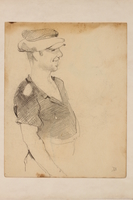
Sketch
Object
Drawing depicting Jacob Barosin’s experiences while interned or living in hiding in southern France from June 1940 to August 1943. In June 1933, Jacob and Sonia Barosin (previously Judey) immigrated illegally to Paris, France, in order to escape the anti-Jewish laws passed following the appointment of Adolf Hitler as chancellor of Germany in January. Jacob voluntarily enlisted in the French military following the 1939 German invasion of Poland. In May1940, Germany invaded France, Jacob and Sonia were arrested as enemy aliens, and Sonia was transported to Gurs internment camp. On June 2, Jacob was transported to Langlade, to serve as a prestataire. Sonia was released from Gurs and traveled to Nice. On May 15, 1941, Jacob was released and moved to Lunel, where Sonia joined him in April 1942. In mid-October, Jacob was sent to Agde internment camp. A friend of his father worked in the camp office and arranged for him to return to Lunel. German forces occupied Lunel in November, so Jacob and Sonia fled to Florac. On February 17, 1943, Jacob was arrested and transported to Gurs, and then sent to a labor camp in Gignac on March 21. Jacob returned to Florac on April 17, and teacher Simone Serriere hid Jacob and Sonia in her schoolhouse in Montmejean. After they were discovered by townspeople, Sonia’s cousins, Boris and Paulette, brought them forged identity papers, and they all returned to Paris in September. Jacob and Sonia were given refuge by Paulette’s mother, until Paris was liberated in late August 1944. The majority of Jacob’s family survived, though his Latvian relatives and his sister, Sina Ida, were murdered during the Holocaust.
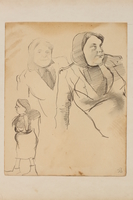
Sketch
Object
Drawing depicting Jacob Barosin’s experiences while interned or living in hiding in southern France from June 1940 to August 1943. In June 1933, Jacob and Sonia Barosin (previously Judey) immigrated illegally to Paris, France, in order to escape the anti-Jewish laws passed following the appointment of Adolf Hitler as chancellor of Germany in January. Jacob voluntarily enlisted in the French military following the 1939 German invasion of Poland. In May1940, Germany invaded France, Jacob and Sonia were arrested as enemy aliens, and Sonia was transported to Gurs internment camp. On June 2, Jacob was transported to Langlade, to serve as a prestataire. Sonia was released from Gurs and traveled to Nice. On May 15, 1941, Jacob was released and moved to Lunel, where Sonia joined him in April 1942. In mid-October, Jacob was sent to Agde internment camp. A friend of his father worked in the camp office and arranged for him to return to Lunel. German forces occupied Lunel in November, so Jacob and Sonia fled to Florac. On February 17, 1943, Jacob was arrested and transported to Gurs, and then sent to a labor camp in Gignac on March 21. Jacob returned to Florac on April 17, and teacher Simone Serriere hid Jacob and Sonia in her schoolhouse in Montmejean. After they were discovered by townspeople, Sonia’s cousins, Boris and Paulette, brought them forged identity papers, and they all returned to Paris in September. Jacob and Sonia were given refuge by Paulette’s mother, until Paris was liberated in late August 1944. The majority of Jacob’s family survived, though his Latvian relatives and his sister, Sina Ida, were murdered during the Holocaust.
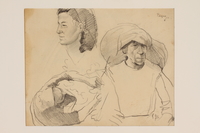
Sketch
Object
Drawing depicting Jacob Barosin’s experiences while interned or living in hiding in southern France from June 1940 to August 1943. In June 1933, Jacob and Sonia Barosin (previously Judey) immigrated illegally to Paris, France, in order to escape the anti-Jewish laws passed following the appointment of Adolf Hitler as chancellor of Germany in January. Jacob voluntarily enlisted in the French military following the 1939 German invasion of Poland. In May1940, Germany invaded France, Jacob and Sonia were arrested as enemy aliens, and Sonia was transported to Gurs internment camp. On June 2, Jacob was transported to Langlade, to serve as a prestataire. Sonia was released from Gurs and traveled to Nice. On May 15, 1941, Jacob was released and moved to Lunel, where Sonia joined him in April 1942. In mid-October, Jacob was sent to Agde internment camp. A friend of his father worked in the camp office and arranged for him to return to Lunel. German forces occupied Lunel in November, so Jacob and Sonia fled to Florac. On February 17, 1943, Jacob was arrested and transported to Gurs, and then sent to a labor camp in Gignac on March 21. Jacob returned to Florac on April 17, and teacher Simone Serriere hid Jacob and Sonia in her schoolhouse in Montmejean. After they were discovered by townspeople, Sonia’s cousins, Boris and Paulette, brought them forged identity papers, and they all returned to Paris in September. Jacob and Sonia were given refuge by Paulette’s mother, until Paris was liberated in late August 1944. The majority of Jacob’s family survived, though his Latvian relatives and his sister, Sina Ida, were murdered during the Holocaust.
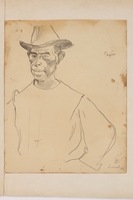
Sketch
Object
Drawing depicting Jacob Barosin’s experiences while interned or living in hiding in southern France from June 1940 to August 1943. In June 1933, Jacob and Sonia Barosin (previously Judey) immigrated illegally to Paris, France, in order to escape the anti-Jewish laws passed following the appointment of Adolf Hitler as chancellor of Germany in January. Jacob voluntarily enlisted in the French military following the 1939 German invasion of Poland. In May1940, Germany invaded France, Jacob and Sonia were arrested as enemy aliens, and Sonia was transported to Gurs internment camp. On June 2, Jacob was transported to Langlade, to serve as a prestataire. Sonia was released from Gurs and traveled to Nice. On May 15, 1941, Jacob was released and moved to Lunel, where Sonia joined him in April 1942. In mid-October, Jacob was sent to Agde internment camp. A friend of his father worked in the camp office and arranged for him to return to Lunel. German forces occupied Lunel in November, so Jacob and Sonia fled to Florac. On February 17, 1943, Jacob was arrested and transported to Gurs, and then sent to a labor camp in Gignac on March 21. Jacob returned to Florac on April 17, and teacher Simone Serriere hid Jacob and Sonia in her schoolhouse in Montmejean. After they were discovered by townspeople, Sonia’s cousins, Boris and Paulette, brought them forged identity papers, and they all returned to Paris in September. Jacob and Sonia were given refuge by Paulette’s mother, until Paris was liberated in late August 1944. The majority of Jacob’s family survived, though his Latvian relatives and his sister, Sina Ida, were murdered during the Holocaust.
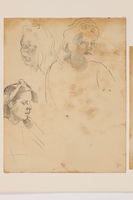
Sketch
Object
Drawing depicting Jacob Barosin’s experiences while interned or living in hiding in southern France from June 1940 to August 1943. In June 1933, Jacob and Sonia Barosin (previously Judey) immigrated illegally to Paris, France, in order to escape the anti-Jewish laws passed following the appointment of Adolf Hitler as chancellor of Germany in January. Jacob voluntarily enlisted in the French military following the 1939 German invasion of Poland. In May1940, Germany invaded France, Jacob and Sonia were arrested as enemy aliens, and Sonia was transported to Gurs internment camp. On June 2, Jacob was transported to Langlade, to serve as a prestataire. Sonia was released from Gurs and traveled to Nice. On May 15, 1941, Jacob was released and moved to Lunel, where Sonia joined him in April 1942. In mid-October, Jacob was sent to Agde internment camp. A friend of his father worked in the camp office and arranged for him to return to Lunel. German forces occupied Lunel in November, so Jacob and Sonia fled to Florac. On February 17, 1943, Jacob was arrested and transported to Gurs, and then sent to a labor camp in Gignac on March 21. Jacob returned to Florac on April 17, and teacher Simone Serriere hid Jacob and Sonia in her schoolhouse in Montmejean. After they were discovered by townspeople, Sonia’s cousins, Boris and Paulette, brought them forged identity papers, and they all returned to Paris in September. Jacob and Sonia were given refuge by Paulette’s mother, until Paris was liberated in late August 1944. The majority of Jacob’s family survived, though his Latvian relatives and his sister, Sina Ida, were murdered during the Holocaust.
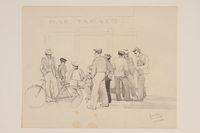
Pencil drawing
Object
Drawing depicting Jacob Barosin’s experiences while interned or living in hiding in southern France from June 1940 to August 1943. In June 1933, Jacob and Sonia Barosin (previously Judey) immigrated illegally to Paris, France, in order to escape the anti-Jewish laws passed following the appointment of Adolf Hitler as chancellor of Germany in January. Jacob voluntarily enlisted in the French military following the 1939 German invasion of Poland. In May1940, Germany invaded France, Jacob and Sonia were arrested as enemy aliens, and Sonia was transported to Gurs internment camp. On June 2, Jacob was transported to Langlade, to serve as a prestataire. Sonia was released from Gurs and traveled to Nice. On May 15, 1941, Jacob was released and moved to Lunel, where Sonia joined him in April 1942. In mid-October, Jacob was sent to Agde internment camp. A friend of his father worked in the camp office and arranged for him to return to Lunel. German forces occupied Lunel in November, so Jacob and Sonia fled to Florac. On February 17, 1943, Jacob was arrested and transported to Gurs, and then sent to a labor camp in Gignac on March 21. Jacob returned to Florac on April 17, and teacher Simone Serriere hid Jacob and Sonia in her schoolhouse in Montmejean. After they were discovered by townspeople, Sonia’s cousins, Boris and Paulette, brought them forged identity papers, and they all returned to Paris in September. Jacob and Sonia were given refuge by Paulette’s mother, until Paris was liberated in late August 1944. The majority of Jacob’s family survived, though his Latvian relatives and his sister, Sina Ida, were murdered during the Holocaust.
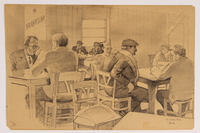
Pencil drawing
Object
Drawing depicting Jacob Barosin’s experiences while interned or living in hiding in southern France from June 1940 to August 1943. In June 1933, Jacob and Sonia Barosin (previously Judey) immigrated illegally to Paris, France, in order to escape the anti-Jewish laws passed following the appointment of Adolf Hitler as chancellor of Germany in January. Jacob voluntarily enlisted in the French military following the 1939 German invasion of Poland. In May1940, Germany invaded France, Jacob and Sonia were arrested as enemy aliens, and Sonia was transported to Gurs internment camp. On June 2, Jacob was transported to Langlade, to serve as a prestataire. Sonia was released from Gurs and traveled to Nice. On May 15, 1941, Jacob was released and moved to Lunel, where Sonia joined him in April 1942. In mid-October, Jacob was sent to Agde internment camp. A friend of his father worked in the camp office and arranged for him to return to Lunel. German forces occupied Lunel in November, so Jacob and Sonia fled to Florac. On February 17, 1943, Jacob was arrested and transported to Gurs, and then sent to a labor camp in Gignac on March 21. Jacob returned to Florac on April 17, and teacher Simone Serriere hid Jacob and Sonia in her schoolhouse in Montmejean. After they were discovered by townspeople, Sonia’s cousins, Boris and Paulette, brought them forged identity papers, and they all returned to Paris in September. Jacob and Sonia were given refuge by Paulette’s mother, until Paris was liberated in late August 1944. The majority of Jacob’s family survived, though his Latvian relatives and his sister, Sina Ida, were murdered during the Holocaust.
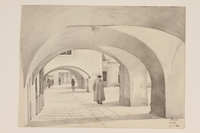
Autobiographical drawing by Jacob Barosin
Object
Drawing depicting Jacob Barosin’s experiences while interned or living in hiding in southern France from June 1940 to August 1943. In June 1933, Jacob and Sonia Barosin (previously Judey) immigrated illegally to Paris, France, in order to escape the anti-Jewish laws passed following the appointment of Adolf Hitler as chancellor of Germany in January. Jacob voluntarily enlisted in the French military following the 1939 German invasion of Poland. In May1940, Germany invaded France, Jacob and Sonia were arrested as enemy aliens, and Sonia was transported to Gurs internment camp. On June 2, Jacob was transported to Langlade, to serve as a prestataire. Sonia was released from Gurs and traveled to Nice. On May 15, 1941, Jacob was released and moved to Lunel, where Sonia joined him in April 1942. In mid-October, Jacob was sent to Agde internment camp. A friend of his father worked in the camp office and arranged for him to return to Lunel. German forces occupied Lunel in November, so Jacob and Sonia fled to Florac. On February 17, 1943, Jacob was arrested and transported to Gurs, and then sent to a labor camp in Gignac on March 21. Jacob returned to Florac on April 17, and teacher Simone Serriere hid Jacob and Sonia in her schoolhouse in Montmejean. After they were discovered by townspeople, Sonia’s cousins, Boris and Paulette, brought them forged identity papers, and they all returned to Paris in September. Jacob and Sonia were given refuge by Paulette’s mother, until Paris was liberated in late August 1944. The majority of Jacob’s family survived, though his Latvian relatives and his sister, Sina Ida, were murdered during the Holocaust.
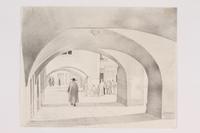
Jacob Barosin drawing of people waiting in a town square
Object
Drawing depicting Jacob Barosin’s experiences while interned or living in hiding in southern France from June 1940 to August 1943. In June 1933, Jacob and Sonia Barosin (previously Judey) immigrated illegally to Paris, France, in order to escape the anti-Jewish laws passed following the appointment of Adolf Hitler as chancellor of Germany in January. Jacob voluntarily enlisted in the French military following the 1939 German invasion of Poland. In May1940, Germany invaded France, Jacob and Sonia were arrested as enemy aliens, and Sonia was transported to Gurs internment camp. On June 2, Jacob was transported to Langlade, to serve as a prestataire. Sonia was released from Gurs and traveled to Nice. On May 15, 1941, Jacob was released and moved to Lunel, where Sonia joined him in April 1942. In mid-October, Jacob was sent to Agde internment camp. A friend of his father worked in the camp office and arranged for him to return to Lunel. German forces occupied Lunel in November, so Jacob and Sonia fled to Florac. On February 17, 1943, Jacob was arrested and transported to Gurs, and then sent to a labor camp in Gignac on March 21. Jacob returned to Florac on April 17, and teacher Simone Serriere hid Jacob and Sonia in her schoolhouse in Montmejean. After they were discovered by townspeople, Sonia’s cousins, Boris and Paulette, brought them forged identity papers, and they all returned to Paris in September. Jacob and Sonia were given refuge by Paulette’s mother, until Paris was liberated in late August 1944. The majority of Jacob’s family survived, though his Latvian relatives and his sister, Sina Ida, were murdered during the Holocaust.
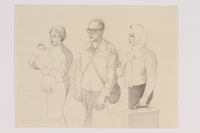
Jacob Barosin drawing of three people walking
Object
Drawing depicting Jacob Barosin’s experiences while interned or living in hiding in southern France from June 1940 to August 1943. In June 1933, Jacob and Sonia Barosin (previously Judey) immigrated illegally to Paris, France, in order to escape the anti-Jewish laws passed following the appointment of Adolf Hitler as chancellor of Germany in January. Jacob voluntarily enlisted in the French military following the 1939 German invasion of Poland. In May1940, Germany invaded France, Jacob and Sonia were arrested as enemy aliens, and Sonia was transported to Gurs internment camp. On June 2, Jacob was transported to Langlade, to serve as a prestataire. Sonia was released from Gurs and traveled to Nice. On May 15, 1941, Jacob was released and moved to Lunel, where Sonia joined him in April 1942. In mid-October, Jacob was sent to Agde internment camp. A friend of his father worked in the camp office and arranged for him to return to Lunel. German forces occupied Lunel in November, so Jacob and Sonia fled to Florac. On February 17, 1943, Jacob was arrested and transported to Gurs, and then sent to a labor camp in Gignac on March 21. Jacob returned to Florac on April 17, and teacher Simone Serriere hid Jacob and Sonia in her schoolhouse in Montmejean. After they were discovered by townspeople, Sonia’s cousins, Boris and Paulette, brought them forged identity papers, and they all returned to Paris in September. Jacob and Sonia were given refuge by Paulette’s mother, until Paris was liberated in late August 1944. The majority of Jacob’s family survived, though his Latvian relatives and his sister, Sina Ida, were murdered during the Holocaust.
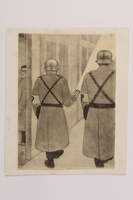
Jacob Barosin drawing of a man hiding from the police
Object
Drawing depicting Jacob Barosin’s experiences while interned or living in hiding in southern France from June 1940 to August 1943. In June 1933, Jacob and Sonia Barosin (previously Judey) immigrated illegally to Paris, France, in order to escape the anti-Jewish laws passed following the appointment of Adolf Hitler as chancellor of Germany in January. Jacob voluntarily enlisted in the French military following the 1939 German invasion of Poland. In May1940, Germany invaded France, Jacob and Sonia were arrested as enemy aliens, and Sonia was transported to Gurs internment camp. On June 2, Jacob was transported to Langlade, to serve as a prestataire. Sonia was released from Gurs and traveled to Nice. On May 15, 1941, Jacob was released and moved to Lunel, where Sonia joined him in April 1942. In mid-October, Jacob was sent to Agde internment camp. A friend of his father worked in the camp office and arranged for him to return to Lunel. German forces occupied Lunel in November, so Jacob and Sonia fled to Florac. On February 17, 1943, Jacob was arrested and transported to Gurs, and then sent to a labor camp in Gignac on March 21. Jacob returned to Florac on April 17, and teacher Simone Serriere hid Jacob and Sonia in her schoolhouse in Montmejean. After they were discovered by townspeople, Sonia’s cousins, Boris and Paulette, brought them forged identity papers, and they all returned to Paris in September. Jacob and Sonia were given refuge by Paulette’s mother, until Paris was liberated in late August 1944. The majority of Jacob’s family survived, though his Latvian relatives and his sister, Sina Ida, were murdered during the Holocaust.
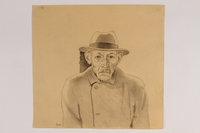
Autobiographical drawing by Jacob Barosin
Object
Drawing depicting Jacob Barosin’s experiences while interned or living in hiding in southern France from June 1940 to August 1943. In June 1933, Jacob and Sonia Barosin (previously Judey) immigrated illegally to Paris, France, in order to escape the anti-Jewish laws passed following the appointment of Adolf Hitler as chancellor of Germany in January. Jacob voluntarily enlisted in the French military following the 1939 German invasion of Poland. In May1940, Germany invaded France, Jacob and Sonia were arrested as enemy aliens, and Sonia was transported to Gurs internment camp. On June 2, Jacob was transported to Langlade, to serve as a prestataire. Sonia was released from Gurs and traveled to Nice. On May 15, 1941, Jacob was released and moved to Lunel, where Sonia joined him in April 1942. In mid-October, Jacob was sent to Agde internment camp. A friend of his father worked in the camp office and arranged for him to return to Lunel. German forces occupied Lunel in November, so Jacob and Sonia fled to Florac. On February 17, 1943, Jacob was arrested and transported to Gurs, and then sent to a labor camp in Gignac on March 21. Jacob returned to Florac on April 17, and teacher Simone Serriere hid Jacob and Sonia in her schoolhouse in Montmejean. After they were discovered by townspeople, Sonia’s cousins, Boris and Paulette, brought them forged identity papers, and they all returned to Paris in September. Jacob and Sonia were given refuge by Paulette’s mother, until Paris was liberated in late August 1944. The majority of Jacob’s family survived, though his Latvian relatives and his sister, Sina Ida, were murdered during the Holocaust.
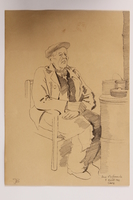
Pencil drawing
Object
Drawing depicting Jacob Barosin’s experiences while interned or living in hiding in southern France from June 1940 to August 1943. In June 1933, Jacob and Sonia Barosin (previously Judey) immigrated illegally to Paris, France, in order to escape the anti-Jewish laws passed following the appointment of Adolf Hitler as chancellor of Germany in January. Jacob voluntarily enlisted in the French military following the 1939 German invasion of Poland. In May1940, Germany invaded France, Jacob and Sonia were arrested as enemy aliens, and Sonia was transported to Gurs internment camp. On June 2, Jacob was transported to Langlade, to serve as a prestataire. Sonia was released from Gurs and traveled to Nice. On May 15, 1941, Jacob was released and moved to Lunel, where Sonia joined him in April 1942. In mid-October, Jacob was sent to Agde internment camp. A friend of his father worked in the camp office and arranged for him to return to Lunel. German forces occupied Lunel in November, so Jacob and Sonia fled to Florac. On February 17, 1943, Jacob was arrested and transported to Gurs, and then sent to a labor camp in Gignac on March 21. Jacob returned to Florac on April 17, and teacher Simone Serriere hid Jacob and Sonia in her schoolhouse in Montmejean. After they were discovered by townspeople, Sonia’s cousins, Boris and Paulette, brought them forged identity papers, and they all returned to Paris in September. Jacob and Sonia were given refuge by Paulette’s mother, until Paris was liberated in late August 1944. The majority of Jacob’s family survived, though his Latvian relatives and his sister, Sina Ida, were murdered during the Holocaust.
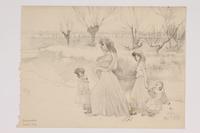
Pencil drawing
Object
Drawing depicting Jacob Barosin’s experiences while interned or living in hiding in southern France from June 1940 to August 1943. In June 1933, Jacob and Sonia Barosin (previously Judey) immigrated illegally to Paris, France, in order to escape the anti-Jewish laws passed following the appointment of Adolf Hitler as chancellor of Germany in January. Jacob voluntarily enlisted in the French military following the 1939 German invasion of Poland. In May1940, Germany invaded France, Jacob and Sonia were arrested as enemy aliens, and Sonia was transported to Gurs internment camp. On June 2, Jacob was transported to Langlade, to serve as a prestataire. Sonia was released from Gurs and traveled to Nice. On May 15, 1941, Jacob was released and moved to Lunel, where Sonia joined him in April 1942. In mid-October, Jacob was sent to Agde internment camp. A friend of his father worked in the camp office and arranged for him to return to Lunel. German forces occupied Lunel in November, so Jacob and Sonia fled to Florac. On February 17, 1943, Jacob was arrested and transported to Gurs, and then sent to a labor camp in Gignac on March 21. Jacob returned to Florac on April 17, and teacher Simone Serriere hid Jacob and Sonia in her schoolhouse in Montmejean. After they were discovered by townspeople, Sonia’s cousins, Boris and Paulette, brought them forged identity papers, and they all returned to Paris in September. Jacob and Sonia were given refuge by Paulette’s mother, until Paris was liberated in late August 1944. The majority of Jacob’s family survived, though his Latvian relatives and his sister, Sina Ida, were murdered during the Holocaust.
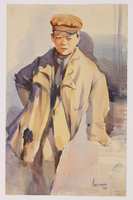
Watercolor painting
Object
Painting depicting Jacob Barosin’s experiences while interned or living in hiding in southern France from June 1940 to August 1943. In June 1933, Jacob and Sonia Barosin (previously Judey) immigrated illegally to Paris, France, in order to escape the anti-Jewish laws passed following the appointment of Adolf Hitler as chancellor of Germany in January. Jacob voluntarily enlisted in the French military following the 1939 German invasion of Poland. In May1940, Germany invaded France, Jacob and Sonia were arrested as enemy aliens, and Sonia was transported to Gurs internment camp. On June 2, Jacob was transported to Langlade, to serve as a prestataire. Sonia was released from Gurs and traveled to Nice. On May 15, 1941, Jacob was released and moved to Lunel, where Sonia joined him in April 1942. In mid-October, Jacob was sent to Agde internment camp. A friend of his father worked in the camp office and arranged for him to return to Lunel. German forces occupied Lunel in November, so Jacob and Sonia fled to Florac. On February 17, 1943, Jacob was arrested and transported to Gurs, and then sent to a labor camp in Gignac on March 21. Jacob returned to Florac on April 17, and teacher Simone Serriere hid Jacob and Sonia in her schoolhouse in Montmejean. After they were discovered by townspeople, Sonia’s cousins, Boris and Paulette, brought them forged identity papers, and they all returned to Paris in September. Jacob and Sonia were given refuge by Paulette’s mother, until Paris was liberated in late August 1944. The majority of Jacob’s family survived, though his Latvian relatives and his sister, Sina Ida, were murdered during the Holocaust.
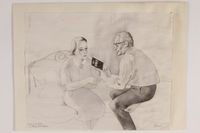
Drawing of a couple in hiding reading a Bible
Object
Drawing depicting Jacob Barosin’s experiences while interned or living in hiding in southern France from June 1940 to August 1943. In June 1933, Jacob and Sonia Barosin (previously Judey) immigrated illegally to Paris, France, in order to escape the anti-Jewish laws passed following the appointment of Adolf Hitler as chancellor of Germany in January. Jacob voluntarily enlisted in the French military following the 1939 German invasion of Poland. In May1940, Germany invaded France, Jacob and Sonia were arrested as enemy aliens, and Sonia was transported to Gurs internment camp. On June 2, Jacob was transported to Langlade, to serve as a prestataire. Sonia was released from Gurs and traveled to Nice. On May 15, 1941, Jacob was released and moved to Lunel, where Sonia joined him in April 1942. In mid-October, Jacob was sent to Agde internment camp. A friend of his father worked in the camp office and arranged for him to return to Lunel. German forces occupied Lunel in November, so Jacob and Sonia fled to Florac. On February 17, 1943, Jacob was arrested and transported to Gurs, and then sent to a labor camp in Gignac on March 21. Jacob returned to Florac on April 17, and teacher Simone Serriere hid Jacob and Sonia in her schoolhouse in Montmejean. After they were discovered by townspeople, Sonia’s cousins, Boris and Paulette, brought them forged identity papers, and they all returned to Paris in September. Jacob and Sonia were given refuge by Paulette’s mother, until Paris was liberated in late August 1944. The majority of Jacob’s family survived, though his Latvian relatives and his sister, Sina Ida, were murdered during the Holocaust.
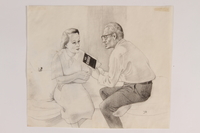
Pencil drawing of a couple reading the Bible
Object
Drawng depicting Jacob Barosin’s experiences while interned or living in hiding in southern France from June 1940 to August 1943. In June 1933, Jacob and Sonia Barosin (previously Judey) immigrated illegally to Paris, France, in order to escape the anti-Jewish laws passed following the appointment of Adolf Hitler as chancellor of Germany in January. Jacob voluntarily enlisted in the French military following the 1939 German invasion of Poland. In May1940, Germany invaded France, Jacob and Sonia were arrested as enemy aliens, and Sonia was transported to Gurs internment camp. On June 2, Jacob was transported to Langlade, to serve as a prestataire. Sonia was released from Gurs and traveled to Nice. On May 15, 1941, Jacob was released and moved to Lunel, where Sonia joined him in April 1942. In mid-October, Jacob was sent to Agde internment camp. A friend of his father worked in the camp office and arranged for him to return to Lunel. German forces occupied Lunel in November, so Jacob and Sonia fled to Florac. On February 17, 1943, Jacob was arrested and transported to Gurs, and then sent to a labor camp in Gignac on March 21. Jacob returned to Florac on April 17, and teacher Simone Serriere hid Jacob and Sonia in her schoolhouse in Montmejean. After they were discovered by townspeople, Sonia’s cousins, Boris and Paulette, brought them forged identity papers, and they all returned to Paris in September. Jacob and Sonia were given refuge by Paulette’s mother, until Paris was liberated in late August 1944. The majority of Jacob’s family survived, though his Latvian relatives and his sister, Sina Ida, were murdered during the Holocaust.
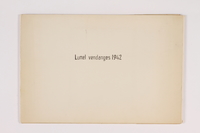
Portfolio front and back covers, "Drawings 1940/1944"
Object
Portfolio covers for drawings depicting Jacob Barosin’s experiences while interned or living in hiding in southern France from June 1940 to August 1943. In June 1933, Jacob and Sonia Barosin (previously Judey) immigrated illegally to Paris, France, in order to escape the anti-Jewish laws passed following the appointment of Adolf Hitler as chancellor of Germany in January. Jacob voluntarily enlisted in the French military following the 1939 German invasion of Poland. In May1940, Germany invaded France, Jacob and Sonia were arrested as enemy aliens, and Sonia was transported to Gurs internment camp. On June 2, Jacob was transported to Langlade, to serve as a prestataire. Sonia was released from Gurs and traveled to Nice. On May 15, 1941, Jacob was released and moved to Lunel, where Sonia joined him in April 1942. In mid-October, Jacob was sent to Agde internment camp. A friend of his father worked in the camp office and arranged for him to return to Lunel. German forces occupied Lunel in November, so Jacob and Sonia fled to Florac. On February 17, 1943, Jacob was arrested and transported to Gurs, and then sent to a labor camp in Gignac on March 21. Jacob returned to Florac on April 17, and teacher Simone Serriere hid Jacob and Sonia in her schoolhouse in Montmejean. After they were discovered by townspeople, Sonia’s cousins, Boris and Paulette, brought them forged identity papers, and they all returned to Paris in September. Jacob and Sonia were given refuge by Paulette’s mother, until Paris was liberated in late August 1944. The majority of Jacob’s family survived, though his Latvian relatives and his sister, Sina Ida, were murdered during the Holocaust.
Jacob Barosin papers
Document
Photographs, documents, slides, and negatives documenting the artwork and career of Jacob Barosin [donor's stepfather] during and after WWII documenting his experiences in the Gurs internment camp, Langlade forced labor camp, while living in hiding, in Paris after the war, and memorializing family and other victims of the Holocaust; dated 1940-1992; in English and French.
Watercolor painting of a garden scene by Jacob J. Barosin
Object
Painting depicting a garden scene in Soisy-sous-Montmorency, a northern suburb of Paris, where Jacob and Sonia Barosin hid from September 1943 to August 1944. In June 1933, Jacob and Sonia Barosin (previously Judey) immigrated illegally to Paris, France, in order to escape the anti-Jewish laws passed following the appointment of Adolf Hitler as chancellor of Germany in January. Jacob voluntarily enlisted in the French military following the 1939 German invasion of Poland. In May1940, Germany invaded France, Jacob and Sonia were arrested as enemy aliens, and Sonia was transported to Gurs internment camp. On June 2, Jacob was transported to Langlade, to serve as a prestataire. Sonia was released from Gurs and traveled to Nice. On May 15, 1941, Jacob was released and moved to Lunel, where Sonia joined him in April 1942. In mid-October, Jacob was sent to Agde internment camp. A friend of his father worked in the camp office and arranged for him to return to Lunel. German forces occupied Lunel in November, so Jacob and Sonia fled to Florac. On February 17, 1943, Jacob was arrested and transported to Gurs, and then sent to a labor camp in Gignac on March 21. Jacob returned to Florac on April 17, and teacher Simone Serriere hid Jacob and Sonia in her schoolhouse in Montmejean. After they were discovered by townspeople, Sonia’s cousins, Boris and Paulette, brought them forged identity papers, and they all returned to Paris in September. Jacob and Sonia were given refuge by Paulette’s mother, until Paris was liberated in late August 1944. The majority of Jacob’s family survived, though his Latvian relatives and his sister, Sina Ida, were murdered during the Holocaust.
Watercolor portrait of an elderly man by Jacob J. Barosin
Object
Watercolor painting depicting an older man created by Jacob Barosin in Esbly, a suburb of Paris, in 1947. In June 1933, Jacob and Sonia Barosin (previously Judey) immigrated illegally to Paris, in order to escape the anti-Jewish laws passed following the appointment of Adolf Hitler as chancellor of Germany in January. Jacob voluntarily enlisted in the French military following the 1939 German invasion of Poland. In May 1940, Germany invaded France, Jacob and Sonia were arrested as enemy aliens, and Sonia was transported to Gurs internment camp. On June 2, Jacob was transported to Langlade, to serve as a prestataire. Sonia was released from Gurs and traveled to Nice. On May 15, 1941, Jacob was released and moved to Lunel, where Sonia joined him in April 1942. In mid-October, Jacob was sent to Agde internment camp. A friend of his father worked in the camp office and arranged for him to return to Lunel. German forces occupied Lunel in November, so Jacob and Sonia fled to Florac. On February 17, 1943, Jacob was arrested and transported to Gurs, and then sent to a labor camp in Gignac on March 21. Jacob returned to Florac on April 17, and teacher Simone Serriere hid Jacob and Sonia in her schoolhouse in Montmejean. After they were discovered by townspeople, Sonia’s cousins, Boris and Paulette, brought them forged identity papers, and they all returned to Paris in September. Jacob and Sonia were given refuge by Paulette’s mother, until Paris was liberated in late August 1944. Jacob and Sonia returned to their prewar apartment, where they lived until their immigration to the United States in October 1947. The majority of Jacob’s family survived, though his Latvian relatives and his sister, Sina Ida, were murdered during the Holocaust.
Pencil portrait of an elderly man by Jacob J. Barosin
Object
Pencil portrait drawn by Jacob Barosin while he was in southern France from June 1940 to August 1943. In June 1933, Jacob and Sonia Barosin (previously Judey) immigrated illegally to Paris, in order to escape the anti-Jewish laws passed following the appointment of Adolf Hitler as chancellor of Germany in January. Jacob voluntarily enlisted in the French military following the 1939 German invasion of Poland. In May 1940, Germany invaded France, Jacob and Sonia were arrested as enemy aliens, and Sonia was transported to Gurs internment camp. On June 2, Jacob was transported to Langlade, to serve as a prestataire. Sonia was released from Gurs and traveled to Nice. On May 15, 1941, Jacob was released and moved to Lunel, where Sonia joined him in April 1942. In mid-October, Jacob was sent to Agde internment camp. A friend of his father worked in the camp office and arranged for him to return to Lunel. German forces occupied Lunel in November, so Jacob and Sonia fled to Florac. On February 17, 1943, Jacob was arrested and transported to Gurs, and then sent to a labor camp in Gignac on March 21. Jacob returned to Florac on April 17, and teacher Simone Serriere hid Jacob and Sonia in her schoolhouse in Montmejean. After they were discovered by townspeople, Sonia’s cousins, Boris and Paulette, brought them forged identity papers, and they all returned to Paris in September. Jacob and Sonia were given refuge by Paulette’s mother, until Paris was liberated in late August 1944. The majority of Jacob’s family survived, though his Latvian relatives and his sister, Sina Ida, were murdered during the Holocaust.
Pencil drawing
Object
Drawing depicting Jacob Barosin’s experiences while interned or living in hiding in southern France from June 1940 to August 1943. In June 1933, Jacob and Sonia Barosin (previously Judey) immigrated illegally to Paris, France, in order to escape the anti-Jewish laws passed following the appointment of Adolf Hitler as chancellor of Germany in January. Jacob voluntarily enlisted in the French military following the 1939 German invasion of Poland. In May1940, Germany invaded France, Jacob and Sonia were arrested as enemy aliens, and Sonia was transported to Gurs internment camp. On June 2, Jacob was transported to Langlade, to serve as a prestataire. Sonia was released from Gurs and traveled to Nice. On May 15, 1941, Jacob was released and moved to Lunel, where Sonia joined him in April 1942. In mid-October, Jacob was sent to Agde internment camp. A friend of his father worked in the camp office and arranged for him to return to Lunel. German forces occupied Lunel in November, so Jacob and Sonia fled to Florac. On February 17, 1943, Jacob was arrested and transported to Gurs, and then sent to a labor camp in Gignac on March 21. Jacob returned to Florac on April 17, and teacher Simone Serriere hid Jacob and Sonia in her schoolhouse in Montmejean. After they were discovered by townspeople, Sonia’s cousins, Boris and Paulette, brought them forged identity papers, and they all returned to Paris in September. Jacob and Sonia were given refuge by Paulette’s mother, until Paris was liberated in late August 1944. The majority of Jacob’s family survived, though his Latvian relatives and his sister, Sina Ida, were murdered during the Holocaust.
Pencil drawing
Object
Drawing depicting Jacob Barosin’s experiences while interned or living in hiding in southern France from June 1940 to August 1943. In June 1933, Jacob and Sonia Barosin (previously Judey) immigrated illegally to Paris, France, in order to escape the anti-Jewish laws passed following the appointment of Adolf Hitler as chancellor of Germany in January. Jacob voluntarily enlisted in the French military following the 1939 German invasion of Poland. In May1940, Germany invaded France, Jacob and Sonia were arrested as enemy aliens, and Sonia was transported to Gurs internment camp. On June 2, Jacob was transported to Langlade, to serve as a prestataire. Sonia was released from Gurs and traveled to Nice. On May 15, 1941, Jacob was released and moved to Lunel, where Sonia joined him in April 1942. In mid-October, Jacob was sent to Agde internment camp. A friend of his father worked in the camp office and arranged for him to return to Lunel. German forces occupied Lunel in November, so Jacob and Sonia fled to Florac. On February 17, 1943, Jacob was arrested and transported to Gurs, and then sent to a labor camp in Gignac on March 21. Jacob returned to Florac on April 17, and teacher Simone Serriere hid Jacob and Sonia in her schoolhouse in Montmejean. After they were discovered by townspeople, Sonia’s cousins, Boris and Paulette, brought them forged identity papers, and they all returned to Paris in September. Jacob and Sonia were given refuge by Paulette’s mother, until Paris was liberated in late August 1944. The majority of Jacob’s family survived, though his Latvian relatives and his sister, Sina Ida, were murdered during the Holocaust.
Watercolor portrait
Object
Painting depicting Jacob Barosin’s experiences while interned or living in hiding in southern France from June 1940 to August 1943. In June 1933, Jacob and Sonia Barosin (previously Judey) immigrated illegally to Paris, France, in order to escape the anti-Jewish laws passed following the appointment of Adolf Hitler as chancellor of Germany in January. Jacob voluntarily enlisted in the French military following the 1939 German invasion of Poland. In May1940, Germany invaded France, Jacob and Sonia were arrested as enemy aliens, and Sonia was transported to Gurs internment camp. On June 2, Jacob was transported to Langlade, to serve as a prestataire. Sonia was released from Gurs and traveled to Nice. On May 15, 1941, Jacob was released and moved to Lunel, where Sonia joined him in April 1942. In mid-October, Jacob was sent to Agde internment camp. A friend of his father worked in the camp office and arranged for him to return to Lunel. German forces occupied Lunel in November, so Jacob and Sonia fled to Florac. On February 17, 1943, Jacob was arrested and transported to Gurs, and then sent to a labor camp in Gignac on March 21. Jacob returned to Florac on April 17, and teacher Simone Serriere hid Jacob and Sonia in her schoolhouse in Montmejean. After they were discovered by townspeople, Sonia’s cousins, Boris and Paulette, brought them forged identity papers, and they all returned to Paris in September. Jacob and Sonia were given refuge by Paulette’s mother, until Paris was liberated in late August 1944. The majority of Jacob’s family survived, though his Latvian relatives and his sister, Sina Ida, were murdered during the Holocaust.
Pencil drawing
Object
Drawing depicting Jacob Barosin’s experiences while interned or living in hiding in southern France from June 1940 to August 1943. In June 1933, Jacob and Sonia Barosin (previously Judey) immigrated illegally to Paris, France, in order to escape the anti-Jewish laws passed following the appointment of Adolf Hitler as chancellor of Germany in January. Jacob voluntarily enlisted in the French military following the 1939 German invasion of Poland. In May1940, Germany invaded France, Jacob and Sonia were arrested as enemy aliens, and Sonia was transported to Gurs internment camp. On June 2, Jacob was transported to Langlade, to serve as a prestataire. Sonia was released from Gurs and traveled to Nice. On May 15, 1941, Jacob was released and moved to Lunel, where Sonia joined him in April 1942. In mid-October, Jacob was sent to Agde internment camp. A friend of his father worked in the camp office and arranged for him to return to Lunel. German forces occupied Lunel in November, so Jacob and Sonia fled to Florac. On February 17, 1943, Jacob was arrested and transported to Gurs, and then sent to a labor camp in Gignac on March 21. Jacob returned to Florac on April 17, and teacher Simone Serriere hid Jacob and Sonia in her schoolhouse in Montmejean. After they were discovered by townspeople, Sonia’s cousins, Boris and Paulette, brought them forged identity papers, and they all returned to Paris in September. Jacob and Sonia were given refuge by Paulette’s mother, until Paris was liberated in late August 1944. The majority of Jacob’s family survived, though his Latvian relatives and his sister, Sina Ida, were murdered during the Holocaust.
Pencil sketch
Object
Drawing depicting Jacob Barosin’s experiences while interned or living in hiding in southern France from June 1940 to August 1943. In June 1933, Jacob and Sonia Barosin (previously Judey) immigrated illegally to Paris, France, in order to escape the anti-Jewish laws passed following the appointment of Adolf Hitler as chancellor of Germany in January. Jacob voluntarily enlisted in the French military following the 1939 German invasion of Poland. In May1940, Germany invaded France, Jacob and Sonia were arrested as enemy aliens, and Sonia was transported to Gurs internment camp. On June 2, Jacob was transported to Langlade, to serve as a prestataire. Sonia was released from Gurs and traveled to Nice. On May 15, 1941, Jacob was released and moved to Lunel, where Sonia joined him in April 1942. In mid-October, Jacob was sent to Agde internment camp. A friend of his father worked in the camp office and arranged for him to return to Lunel. German forces occupied Lunel in November, so Jacob and Sonia fled to Florac. On February 17, 1943, Jacob was arrested and transported to Gurs, and then sent to a labor camp in Gignac on March 21. Jacob returned to Florac on April 17, and teacher Simone Serriere hid Jacob and Sonia in her schoolhouse in Montmejean. After they were discovered by townspeople, Sonia’s cousins, Boris and Paulette, brought them forged identity papers, and they all returned to Paris in September. Jacob and Sonia were given refuge by Paulette’s mother, until Paris was liberated in late August 1944. The majority of Jacob’s family survived, though his Latvian relatives and his sister, Sina Ida, were murdered during the Holocaust.
Pencil drawing
Object
Drawing depicting Jacob Barosin’s experiences while interned or living in hiding in southern France from June 1940 to August 1943. In June 1933, Jacob and Sonia Barosin (previously Judey) immigrated illegally to Paris, France, in order to escape the anti-Jewish laws passed following the appointment of Adolf Hitler as chancellor of Germany in January. Jacob voluntarily enlisted in the French military following the 1939 German invasion of Poland. In May1940, Germany invaded France, Jacob and Sonia were arrested as enemy aliens, and Sonia was transported to Gurs internment camp. On June 2, Jacob was transported to Langlade, to serve as a prestataire. Sonia was released from Gurs and traveled to Nice. On May 15, 1941, Jacob was released and moved to Lunel, where Sonia joined him in April 1942. In mid-October, Jacob was sent to Agde internment camp. A friend of his father worked in the camp office and arranged for him to return to Lunel. German forces occupied Lunel in November, so Jacob and Sonia fled to Florac. On February 17, 1943, Jacob was arrested and transported to Gurs, and then sent to a labor camp in Gignac on March 21. Jacob returned to Florac on April 17, and teacher Simone Serriere hid Jacob and Sonia in her schoolhouse in Montmejean. After they were discovered by townspeople, Sonia’s cousins, Boris and Paulette, brought them forged identity papers, and they all returned to Paris in September. Jacob and Sonia were given refuge by Paulette’s mother, until Paris was liberated in late August 1944. The majority of Jacob’s family survived, though his Latvian relatives and his sister, Sina Ida, were murdered during the Holocaust.
Watercolor portrait
Object
Painting depicting Jacob Barosin’s experiences while interned or living in hiding in southern France from June 1940 to August 1943. In June 1933, Jacob and Sonia Barosin (previously Judey) immigrated illegally to Paris, France, in order to escape the anti-Jewish laws passed following the appointment of Adolf Hitler as chancellor of Germany in January. Jacob voluntarily enlisted in the French military following the 1939 German invasion of Poland. In May1940, Germany invaded France, Jacob and Sonia were arrested as enemy aliens, and Sonia was transported to Gurs internment camp. On June 2, Jacob was transported to Langlade, to serve as a prestataire. Sonia was released from Gurs and traveled to Nice. On May 15, 1941, Jacob was released and moved to Lunel, where Sonia joined him in April 1942. In mid-October, Jacob was sent to Agde internment camp. A friend of his father worked in the camp office and arranged for him to return to Lunel. German forces occupied Lunel in November, so Jacob and Sonia fled to Florac. On February 17, 1943, Jacob was arrested and transported to Gurs, and then sent to a labor camp in Gignac on March 21. Jacob returned to Florac on April 17, and teacher Simone Serriere hid Jacob and Sonia in her schoolhouse in Montmejean. After they were discovered by townspeople, Sonia’s cousins, Boris and Paulette, brought them forged identity papers, and they all returned to Paris in September. Jacob and Sonia were given refuge by Paulette’s mother, until Paris was liberated in late August 1944. The majority of Jacob’s family survived, though his Latvian relatives and his sister, Sina Ida, were murdered during the Holocaust.
Watercolor portrait
Object
Painting depicting Jacob Barosin’s experiences while interned or living in hiding in southern France from June 1940 to August 1943. In June 1933, Jacob and Sonia Barosin (previously Judey) immigrated illegally to Paris, France, in order to escape the anti-Jewish laws passed following the appointment of Adolf Hitler as chancellor of Germany in January. Jacob voluntarily enlisted in the French military following the 1939 German invasion of Poland. In May1940, Germany invaded France, Jacob and Sonia were arrested as enemy aliens, and Sonia was transported to Gurs internment camp. On June 2, Jacob was transported to Langlade, to serve as a prestataire. Sonia was released from Gurs and traveled to Nice. On May 15, 1941, Jacob was released and moved to Lunel, where Sonia joined him in April 1942. In mid-October, Jacob was sent to Agde internment camp. A friend of his father worked in the camp office and arranged for him to return to Lunel. German forces occupied Lunel in November, so Jacob and Sonia fled to Florac. On February 17, 1943, Jacob was arrested and transported to Gurs, and then sent to a labor camp in Gignac on March 21. Jacob returned to Florac on April 17, and teacher Simone Serriere hid Jacob and Sonia in her schoolhouse in Montmejean. After they were discovered by townspeople, Sonia’s cousins, Boris and Paulette, brought them forged identity papers, and they all returned to Paris in September. Jacob and Sonia were given refuge by Paulette’s mother, until Paris was liberated in late August 1944. The majority of Jacob’s family survived, though his Latvian relatives and his sister, Sina Ida, were murdered during the Holocaust.
Watercolor portrait
Object
Painting depicting Jacob Barosin’s experiences while interned or living in hiding in southern France from June 1940 to August 1943. In June 1933, Jacob and Sonia Barosin (previously Judey) immigrated illegally to Paris, France, in order to escape the anti-Jewish laws passed following the appointment of Adolf Hitler as chancellor of Germany in January. Jacob voluntarily enlisted in the French military following the 1939 German invasion of Poland. In May1940, Germany invaded France, Jacob and Sonia were arrested as enemy aliens, and Sonia was transported to Gurs internment camp. On June 2, Jacob was transported to Langlade, to serve as a prestataire. Sonia was released from Gurs and traveled to Nice. On May 15, 1941, Jacob was released and moved to Lunel, where Sonia joined him in April 1942. In mid-October, Jacob was sent to Agde internment camp. A friend of his father worked in the camp office and arranged for him to return to Lunel. German forces occupied Lunel in November, so Jacob and Sonia fled to Florac. On February 17, 1943, Jacob was arrested and transported to Gurs, and then sent to a labor camp in Gignac on March 21. Jacob returned to Florac on April 17, and teacher Simone Serriere hid Jacob and Sonia in her schoolhouse in Montmejean. After they were discovered by townspeople, Sonia’s cousins, Boris and Paulette, brought them forged identity papers, and they all returned to Paris in September. Jacob and Sonia were given refuge by Paulette’s mother, until Paris was liberated in late August 1944. The majority of Jacob’s family survived, though his Latvian relatives and his sister, Sina Ida, were murdered during the Holocaust.
Watercolor portrait
Object
Painting depicting Jacob Barosin’s experiences while interned or living in hiding in southern France from June 1940 to August 1943. In June 1933, Jacob and Sonia Barosin (previously Judey) immigrated illegally to Paris, France, in order to escape the anti-Jewish laws passed following the appointment of Adolf Hitler as chancellor of Germany in January. Jacob voluntarily enlisted in the French military following the 1939 German invasion of Poland. In May1940, Germany invaded France, Jacob and Sonia were arrested as enemy aliens, and Sonia was transported to Gurs internment camp. On June 2, Jacob was transported to Langlade, to serve as a prestataire. Sonia was released from Gurs and traveled to Nice. On May 15, 1941, Jacob was released and moved to Lunel, where Sonia joined him in April 1942. In mid-October, Jacob was sent to Agde internment camp. A friend of his father worked in the camp office and arranged for him to return to Lunel. German forces occupied Lunel in November, so Jacob and Sonia fled to Florac. On February 17, 1943, Jacob was arrested and transported to Gurs, and then sent to a labor camp in Gignac on March 21. Jacob returned to Florac on April 17, and teacher Simone Serriere hid Jacob and Sonia in her schoolhouse in Montmejean. After they were discovered by townspeople, Sonia’s cousins, Boris and Paulette, brought them forged identity papers, and they all returned to Paris in September. Jacob and Sonia were given refuge by Paulette’s mother, until Paris was liberated in late August 1944. The majority of Jacob’s family survived, though his Latvian relatives and his sister, Sina Ida, were murdered during the Holocaust.
Watercolor portrait
Object
Painting depicting Jacob Barosin’s experiences while interned or living in hiding in southern France from June 1940 to August 1943. In June 1933, Jacob and Sonia Barosin (previously Judey) immigrated illegally to Paris, France, in order to escape the anti-Jewish laws passed following the appointment of Adolf Hitler as chancellor of Germany in January. Jacob voluntarily enlisted in the French military following the 1939 German invasion of Poland. In May1940, Germany invaded France, Jacob and Sonia were arrested as enemy aliens, and Sonia was transported to Gurs internment camp. On June 2, Jacob was transported to Langlade, to serve as a prestataire. Sonia was released from Gurs and traveled to Nice. On May 15, 1941, Jacob was released and moved to Lunel, where Sonia joined him in April 1942. In mid-October, Jacob was sent to Agde internment camp. A friend of his father worked in the camp office and arranged for him to return to Lunel. German forces occupied Lunel in November, so Jacob and Sonia fled to Florac. On February 17, 1943, Jacob was arrested and transported to Gurs, and then sent to a labor camp in Gignac on March 21. Jacob returned to Florac on April 17, and teacher Simone Serriere hid Jacob and Sonia in her schoolhouse in Montmejean. After they were discovered by townspeople, Sonia’s cousins, Boris and Paulette, brought them forged identity papers, and they all returned to Paris in September. Jacob and Sonia were given refuge by Paulette’s mother, until Paris was liberated in late August 1944. The majority of Jacob’s family survived, though his Latvian relatives and his sister, Sina Ida, were murdered during the Holocaust.
Watercolor portrait
Object
Painting depicting Jacob Barosin’s experiences while interned or living in hiding in southern France from June 1940 to August 1943. In June 1933, Jacob and Sonia Barosin (previously Judey) immigrated illegally to Paris, France, in order to escape the anti-Jewish laws passed following the appointment of Adolf Hitler as chancellor of Germany in January. Jacob voluntarily enlisted in the French military following the 1939 German invasion of Poland. In May1940, Germany invaded France, Jacob and Sonia were arrested as enemy aliens, and Sonia was transported to Gurs internment camp. On June 2, Jacob was transported to Langlade, to serve as a prestataire. Sonia was released from Gurs and traveled to Nice. On May 15, 1941, Jacob was released and moved to Lunel, where Sonia joined him in April 1942. In mid-October, Jacob was sent to Agde internment camp. A friend of his father worked in the camp office and arranged for him to return to Lunel. German forces occupied Lunel in November, so Jacob and Sonia fled to Florac. On February 17, 1943, Jacob was arrested and transported to Gurs, and then sent to a labor camp in Gignac on March 21. Jacob returned to Florac on April 17, and teacher Simone Serriere hid Jacob and Sonia in her schoolhouse in Montmejean. After they were discovered by townspeople, Sonia’s cousins, Boris and Paulette, brought them forged identity papers, and they all returned to Paris in September. Jacob and Sonia were given refuge by Paulette’s mother, until Paris was liberated in late August 1944. The majority of Jacob’s family survived, though his Latvian relatives and his sister, Sina Ida, were murdered during the Holocaust.
Watercolor portrait
Object
Painting depicting Jacob Barosin’s experiences while interned or living in hiding in southern France from June 1940 to August 1943. In June 1933, Jacob and Sonia Barosin (previously Judey) immigrated illegally to Paris, France, in order to escape the anti-Jewish laws passed following the appointment of Adolf Hitler as chancellor of Germany in January. Jacob voluntarily enlisted in the French military following the 1939 German invasion of Poland. In May1940, Germany invaded France, Jacob and Sonia were arrested as enemy aliens, and Sonia was transported to Gurs internment camp. On June 2, Jacob was transported to Langlade, to serve as a prestataire. Sonia was released from Gurs and traveled to Nice. On May 15, 1941, Jacob was released and moved to Lunel, where Sonia joined him in April 1942. In mid-October, Jacob was sent to Agde internment camp. A friend of his father worked in the camp office and arranged for him to return to Lunel. German forces occupied Lunel in November, so Jacob and Sonia fled to Florac. On February 17, 1943, Jacob was arrested and transported to Gurs, and then sent to a labor camp in Gignac on March 21. Jacob returned to Florac on April 17, and teacher Simone Serriere hid Jacob and Sonia in her schoolhouse in Montmejean. After they were discovered by townspeople, Sonia’s cousins, Boris and Paulette, brought them forged identity papers, and they all returned to Paris in September. Jacob and Sonia were given refuge by Paulette’s mother, until Paris was liberated in late August 1944. The majority of Jacob’s family survived, though his Latvian relatives and his sister, Sina Ida, were murdered during the Holocaust.
Pencil drawing
Object
Drawing depicting Jacob Barosin’s experiences while interned or living in hiding in southern France from June 1940 to August 1943. In June 1933, Jacob and Sonia Barosin (previously Judey) immigrated illegally to Paris, France, in order to escape the anti-Jewish laws passed following the appointment of Adolf Hitler as chancellor of Germany in January. Jacob voluntarily enlisted in the French military following the 1939 German invasion of Poland. In May1940, Germany invaded France, Jacob and Sonia were arrested as enemy aliens, and Sonia was transported to Gurs internment camp. On June 2, Jacob was transported to Langlade, to serve as a prestataire. Sonia was released from Gurs and traveled to Nice. On May 15, 1941, Jacob was released and moved to Lunel, where Sonia joined him in April 1942. In mid-October, Jacob was sent to Agde internment camp. A friend of his father worked in the camp office and arranged for him to return to Lunel. German forces occupied Lunel in November, so Jacob and Sonia fled to Florac. On February 17, 1943, Jacob was arrested and transported to Gurs, and then sent to a labor camp in Gignac on March 21. Jacob returned to Florac on April 17, and teacher Simone Serriere hid Jacob and Sonia in her schoolhouse in Montmejean. After they were discovered by townspeople, Sonia’s cousins, Boris and Paulette, brought them forged identity papers, and they all returned to Paris in September. Jacob and Sonia were given refuge by Paulette’s mother, until Paris was liberated in late August 1944. The majority of Jacob’s family survived, though his Latvian relatives and his sister, Sina Ida, were murdered during the Holocaust.
Pencil drawing
Object
Drawing depicting Jacob Barosin’s experiences while interned or living in hiding in southern France from June 1940 to August 1943. In June 1933, Jacob and Sonia Barosin (previously Judey) immigrated illegally to Paris, France, in order to escape the anti-Jewish laws passed following the appointment of Adolf Hitler as chancellor of Germany in January. Jacob voluntarily enlisted in the French military following the 1939 German invasion of Poland. In May1940, Germany invaded France, Jacob and Sonia were arrested as enemy aliens, and Sonia was transported to Gurs internment camp. On June 2, Jacob was transported to Langlade, to serve as a prestataire. Sonia was released from Gurs and traveled to Nice. On May 15, 1941, Jacob was released and moved to Lunel, where Sonia joined him in April 1942. In mid-October, Jacob was sent to Agde internment camp. A friend of his father worked in the camp office and arranged for him to return to Lunel. German forces occupied Lunel in November, so Jacob and Sonia fled to Florac. On February 17, 1943, Jacob was arrested and transported to Gurs, and then sent to a labor camp in Gignac on March 21. Jacob returned to Florac on April 17, and teacher Simone Serriere hid Jacob and Sonia in her schoolhouse in Montmejean. After they were discovered by townspeople, Sonia’s cousins, Boris and Paulette, brought them forged identity papers, and they all returned to Paris in September. Jacob and Sonia were given refuge by Paulette’s mother, until Paris was liberated in late August 1944. The majority of Jacob’s family survived, though his Latvian relatives and his sister, Sina Ida, were murdered during the Holocaust.
Pencil drawing
Object
Drawing depicting Jacob Barosin’s experiences while interned or living in hiding in southern France from June 1940 to August 1943. In June 1933, Jacob and Sonia Barosin (previously Judey) immigrated illegally to Paris, France, in order to escape the anti-Jewish laws passed following the appointment of Adolf Hitler as chancellor of Germany in January. Jacob voluntarily enlisted in the French military following the 1939 German invasion of Poland. In May1940, Germany invaded France, Jacob and Sonia were arrested as enemy aliens, and Sonia was transported to Gurs internment camp. On June 2, Jacob was transported to Langlade, to serve as a prestataire. Sonia was released from Gurs and traveled to Nice. On May 15, 1941, Jacob was released and moved to Lunel, where Sonia joined him in April 1942. In mid-October, Jacob was sent to Agde internment camp. A friend of his father worked in the camp office and arranged for him to return to Lunel. German forces occupied Lunel in November, so Jacob and Sonia fled to Florac. On February 17, 1943, Jacob was arrested and transported to Gurs, and then sent to a labor camp in Gignac on March 21. Jacob returned to Florac on April 17, and teacher Simone Serriere hid Jacob and Sonia in her schoolhouse in Montmejean. After they were discovered by townspeople, Sonia’s cousins, Boris and Paulette, brought them forged identity papers, and they all returned to Paris in September. Jacob and Sonia were given refuge by Paulette’s mother, until Paris was liberated in late August 1944. The majority of Jacob’s family survived, though his Latvian relatives and his sister, Sina Ida, were murdered during the Holocaust.
Pencil drawing
Object
Drawing depicting Jacob Barosin’s experiences while interned or living in hiding in southern France from June 1940 to August 1943. In June 1933, Jacob and Sonia Barosin (previously Judey) immigrated illegally to Paris, France, in order to escape the anti-Jewish laws passed following the appointment of Adolf Hitler as chancellor of Germany in January. Jacob voluntarily enlisted in the French military following the 1939 German invasion of Poland. In May1940, Germany invaded France, Jacob and Sonia were arrested as enemy aliens, and Sonia was transported to Gurs internment camp. On June 2, Jacob was transported to Langlade, to serve as a prestataire. Sonia was released from Gurs and traveled to Nice. On May 15, 1941, Jacob was released and moved to Lunel, where Sonia joined him in April 1942. In mid-October, Jacob was sent to Agde internment camp. A friend of his father worked in the camp office and arranged for him to return to Lunel. German forces occupied Lunel in November, so Jacob and Sonia fled to Florac. On February 17, 1943, Jacob was arrested and transported to Gurs, and then sent to a labor camp in Gignac on March 21. Jacob returned to Florac on April 17, and teacher Simone Serriere hid Jacob and Sonia in her schoolhouse in Montmejean. After they were discovered by townspeople, Sonia’s cousins, Boris and Paulette, brought them forged identity papers, and they all returned to Paris in September. Jacob and Sonia were given refuge by Paulette’s mother, until Paris was liberated in late August 1944. The majority of Jacob’s family survived, though his Latvian relatives and his sister, Sina Ida, were murdered during the Holocaust.
Drawing
Object
Drawing depicting Jacob Barosin’s experiences while interned or living in hiding in southern France from June 1940 to August 1943. In June 1933, Jacob and Sonia Barosin (previously Judey) immigrated illegally to Paris, France, in order to escape the anti-Jewish laws passed following the appointment of Adolf Hitler as chancellor of Germany in January. Jacob voluntarily enlisted in the French military following the 1939 German invasion of Poland. In May1940, Germany invaded France, Jacob and Sonia were arrested as enemy aliens, and Sonia was transported to Gurs internment camp. On June 2, Jacob was transported to Langlade, to serve as a prestataire. Sonia was released from Gurs and traveled to Nice. On May 15, 1941, Jacob was released and moved to Lunel, where Sonia joined him in April 1942. In mid-October, Jacob was sent to Agde internment camp. A friend of his father worked in the camp office and arranged for him to return to Lunel. German forces occupied Lunel in November, so Jacob and Sonia fled to Florac. On February 17, 1943, Jacob was arrested and transported to Gurs, and then sent to a labor camp in Gignac on March 21. Jacob returned to Florac on April 17, and teacher Simone Serriere hid Jacob and Sonia in her schoolhouse in Montmejean. After they were discovered by townspeople, Sonia’s cousins, Boris and Paulette, brought them forged identity papers, and they all returned to Paris in September. Jacob and Sonia were given refuge by Paulette’s mother, until Paris was liberated in late August 1944. The majority of Jacob’s family survived, though his Latvian relatives and his sister, Sina Ida, were murdered during the Holocaust.
Jacob Barosin drawing of the Nice promenade
Object
Drawing depicting Jacob Barosin’s experiences while interned or living in hiding in southern France from June 1940 to August 1943. In June 1933, Jacob and Sonia Barosin (previously Judey) immigrated illegally to Paris, France, in order to escape the anti-Jewish laws passed following the appointment of Adolf Hitler as chancellor of Germany in January. Jacob voluntarily enlisted in the French military following the 1939 German invasion of Poland. In May1940, Germany invaded France, Jacob and Sonia were arrested as enemy aliens, and Sonia was transported to Gurs internment camp. On June 2, Jacob was transported to Langlade, to serve as a prestataire. Sonia was released from Gurs and traveled to Nice. On May 15, 1941, Jacob was released and moved to Lunel, where Sonia joined him in April 1942. In mid-October, Jacob was sent to Agde internment camp. A friend of his father worked in the camp office and arranged for him to return to Lunel. German forces occupied Lunel in November, so Jacob and Sonia fled to Florac. On February 17, 1943, Jacob was arrested and transported to Gurs, and then sent to a labor camp in Gignac on March 21. Jacob returned to Florac on April 17, and teacher Simone Serriere hid Jacob and Sonia in her schoolhouse in Montmejean. After they were discovered by townspeople, Sonia’s cousins, Boris and Paulette, brought them forged identity papers, and they all returned to Paris in September. Jacob and Sonia were given refuge by Paulette’s mother, until Paris was liberated in late August 1944. The majority of Jacob’s family survived, though his Latvian relatives and his sister, Sina Ida, were murdered during the Holocaust.
Watercolor portrait
Object
Painting depicting Jacob Barosin’s experiences while interned or living in hiding in southern France from June 1940 to August 1943. In June 1933, Jacob and Sonia Barosin (previously Judey) immigrated illegally to Paris, France, in order to escape the anti-Jewish laws passed following the appointment of Adolf Hitler as chancellor of Germany in January. Jacob voluntarily enlisted in the French military following the 1939 German invasion of Poland. In May1940, Germany invaded France, Jacob and Sonia were arrested as enemy aliens, and Sonia was transported to Gurs internment camp. On June 2, Jacob was transported to Langlade, to serve as a prestataire. Sonia was released from Gurs and traveled to Nice. On May 15, 1941, Jacob was released and moved to Lunel, where Sonia joined him in April 1942. In mid-October, Jacob was sent to Agde internment camp. A friend of his father worked in the camp office and arranged for him to return to Lunel. German forces occupied Lunel in November, so Jacob and Sonia fled to Florac. On February 17, 1943, Jacob was arrested and transported to Gurs, and then sent to a labor camp in Gignac on March 21. Jacob returned to Florac on April 17, and teacher Simone Serriere hid Jacob and Sonia in her schoolhouse in Montmejean. After they were discovered by townspeople, Sonia’s cousins, Boris and Paulette, brought them forged identity papers, and they all returned to Paris in September. Jacob and Sonia were given refuge by Paulette’s mother, until Paris was liberated in late August 1944. The majority of Jacob’s family survived, though his Latvian relatives and his sister, Sina Ida, were murdered during the Holocaust.
Jacob Barosin drawing of a US jeep on a Paris street
Object
Drawing depicting Jacob Barosin’s experiences while interned or living in hiding in southern France from June 1940 to August 1943. In June 1933, Jacob and Sonia Barosin (previously Judey) immigrated illegally to Paris, France, in order to escape the anti-Jewish laws passed following the appointment of Adolf Hitler as chancellor of Germany in January. Jacob voluntarily enlisted in the French military following the 1939 German invasion of Poland. In May1940, Germany invaded France, Jacob and Sonia were arrested as enemy aliens, and Sonia was transported to Gurs internment camp. On June 2, Jacob was transported to Langlade, to serve as a prestataire. Sonia was released from Gurs and traveled to Nice. On May 15, 1941, Jacob was released and moved to Lunel, where Sonia joined him in April 1942. In mid-October, Jacob was sent to Agde internment camp. A friend of his father worked in the camp office and arranged for him to return to Lunel. German forces occupied Lunel in November, so Jacob and Sonia fled to Florac. On February 17, 1943, Jacob was arrested and transported to Gurs, and then sent to a labor camp in Gignac on March 21. Jacob returned to Florac on April 17, and teacher Simone Serriere hid Jacob and Sonia in her schoolhouse in Montmejean. After they were discovered by townspeople, Sonia’s cousins, Boris and Paulette, brought them forged identity papers, and they all returned to Paris in September. Jacob and Sonia were given refuge by Paulette’s mother, until Paris was liberated in late August 1944. The majority of Jacob’s family survived, though his Latvian relatives and his sister, Sina Ida, were murdered during the Holocaust.
Jacob Barosin drawing of people looking at bombed building
Object
Drawing depicting Jacob Barosin’s experiences while interned or living in hiding in southern France from June 1940 to August 1943. In June 1933, Jacob and Sonia Barosin (previously Judey) immigrated illegally to Paris, France, in order to escape the anti-Jewish laws passed following the appointment of Adolf Hitler as chancellor of Germany in January. Jacob voluntarily enlisted in the French military following the 1939 German invasion of Poland. In May1940, Germany invaded France, Jacob and Sonia were arrested as enemy aliens, and Sonia was transported to Gurs internment camp. On June 2, Jacob was transported to Langlade, to serve as a prestataire. Sonia was released from Gurs and traveled to Nice. On May 15, 1941, Jacob was released and moved to Lunel, where Sonia joined him in April 1942. In mid-October, Jacob was sent to Agde internment camp. A friend of his father worked in the camp office and arranged for him to return to Lunel. German forces occupied Lunel in November, so Jacob and Sonia fled to Florac. On February 17, 1943, Jacob was arrested and transported to Gurs, and then sent to a labor camp in Gignac on March 21. Jacob returned to Florac on April 17, and teacher Simone Serriere hid Jacob and Sonia in her schoolhouse in Montmejean. After they were discovered by townspeople, Sonia’s cousins, Boris and Paulette, brought them forged identity papers, and they all returned to Paris in September. Jacob and Sonia were given refuge by Paulette’s mother, until Paris was liberated in late August 1944. The majority of Jacob’s family survived, though his Latvian relatives and his sister, Sina Ida, were murdered during the Holocaust.
Jacob Barosin drawing of a man sleeping in a labor camp barrack
Object
Drawing depicting Jacob Barosin’s experiences while interned or living in hiding in southern France from June 1940 to August 1943. In June 1933, Jacob and Sonia Barosin (previously Judey) immigrated illegally to Paris, France, in order to escape the anti-Jewish laws passed following the appointment of Adolf Hitler as chancellor of Germany in January. Jacob voluntarily enlisted in the French military following the 1939 German invasion of Poland. In May1940, Germany invaded France, Jacob and Sonia were arrested as enemy aliens, and Sonia was transported to Gurs internment camp. On June 2, Jacob was transported to Langlade, to serve as a prestataire. Sonia was released from Gurs and traveled to Nice. On May 15, 1941, Jacob was released and moved to Lunel, where Sonia joined him in April 1942. In mid-October, Jacob was sent to Agde internment camp. A friend of his father worked in the camp office and arranged for him to return to Lunel. German forces occupied Lunel in November, so Jacob and Sonia fled to Florac. On February 17, 1943, Jacob was arrested and transported to Gurs, and then sent to a labor camp in Gignac on March 21. Jacob returned to Florac on April 17, and teacher Simone Serriere hid Jacob and Sonia in her schoolhouse in Montmejean. After they were discovered by townspeople, Sonia’s cousins, Boris and Paulette, brought them forged identity papers, and they all returned to Paris in September. Jacob and Sonia were given refuge by Paulette’s mother, until Paris was liberated in late August 1944. The majority of Jacob’s family survived, though his Latvian relatives and his sister, Sina Ida, were murdered during the Holocaust.
Jacob Barosin drawing of men standing near the fence in a labor camp
Object
Drawing depicting Jacob Barosin’s experiences while interned or living in hiding in southern France from June 1940 to August 1943. In June 1933, Jacob and Sonia Barosin (previously Judey) immigrated illegally to Paris, France, in order to escape the anti-Jewish laws passed following the appointment of Adolf Hitler as chancellor of Germany in January. Jacob voluntarily enlisted in the French military following the 1939 German invasion of Poland. In May1940, Germany invaded France, Jacob and Sonia were arrested as enemy aliens, and Sonia was transported to Gurs internment camp. On June 2, Jacob was transported to Langlade, to serve as a prestataire. Sonia was released from Gurs and traveled to Nice. On May 15, 1941, Jacob was released and moved to Lunel, where Sonia joined him in April 1942. In mid-October, Jacob was sent to Agde internment camp. A friend of his father worked in the camp office and arranged for him to return to Lunel. German forces occupied Lunel in November, so Jacob and Sonia fled to Florac. On February 17, 1943, Jacob was arrested and transported to Gurs, and then sent to a labor camp in Gignac on March 21. Jacob returned to Florac on April 17, and teacher Simone Serriere hid Jacob and Sonia in her schoolhouse in Montmejean. After they were discovered by townspeople, Sonia’s cousins, Boris and Paulette, brought them forged identity papers, and they all returned to Paris in September. Jacob and Sonia were given refuge by Paulette’s mother, until Paris was liberated in late August 1944. The majority of Jacob’s family survived, though his Latvian relatives and his sister, Sina Ida, were murdered during the Holocaust.
Pencil drawing
Object
Drawing depicting Jacob Barosin’s experiences while interned or living in hiding in southern France from June 1940 to August 1943. In June 1933, Jacob and Sonia Barosin (previously Judey) immigrated illegally to Paris, France, in order to escape the anti-Jewish laws passed following the appointment of Adolf Hitler as chancellor of Germany in January. Jacob voluntarily enlisted in the French military following the 1939 German invasion of Poland. In May1940, Germany invaded France, Jacob and Sonia were arrested as enemy aliens, and Sonia was transported to Gurs internment camp. On June 2, Jacob was transported to Langlade, to serve as a prestataire. Sonia was released from Gurs and traveled to Nice. On May 15, 1941, Jacob was released and moved to Lunel, where Sonia joined him in April 1942. In mid-October, Jacob was sent to Agde internment camp. A friend of his father worked in the camp office and arranged for him to return to Lunel. German forces occupied Lunel in November, so Jacob and Sonia fled to Florac. On February 17, 1943, Jacob was arrested and transported to Gurs, and then sent to a labor camp in Gignac on March 21. Jacob returned to Florac on April 17, and teacher Simone Serriere hid Jacob and Sonia in her schoolhouse in Montmejean. After they were discovered by townspeople, Sonia’s cousins, Boris and Paulette, brought them forged identity papers, and they all returned to Paris in September. Jacob and Sonia were given refuge by Paulette’s mother, until Paris was liberated in late August 1944. The majority of Jacob’s family survived, though his Latvian relatives and his sister, Sina Ida, were murdered during the Holocaust.
Pencil drawing
Object
Drawing depicting Jacob Barosin’s experiences while interned or living in hiding in southern France from June 1940 to August 1943. In June 1933, Jacob and Sonia Barosin (previously Judey) immigrated illegally to Paris, France, in order to escape the anti-Jewish laws passed following the appointment of Adolf Hitler as chancellor of Germany in January. Jacob voluntarily enlisted in the French military following the 1939 German invasion of Poland. In May1940, Germany invaded France, Jacob and Sonia were arrested as enemy aliens, and Sonia was transported to Gurs internment camp. On June 2, Jacob was transported to Langlade, to serve as a prestataire. Sonia was released from Gurs and traveled to Nice. On May 15, 1941, Jacob was released and moved to Lunel, where Sonia joined him in April 1942. In mid-October, Jacob was sent to Agde internment camp. A friend of his father worked in the camp office and arranged for him to return to Lunel. German forces occupied Lunel in November, so Jacob and Sonia fled to Florac. On February 17, 1943, Jacob was arrested and transported to Gurs, and then sent to a labor camp in Gignac on March 21. Jacob returned to Florac on April 17, and teacher Simone Serriere hid Jacob and Sonia in her schoolhouse in Montmejean. After they were discovered by townspeople, Sonia’s cousins, Boris and Paulette, brought them forged identity papers, and they all returned to Paris in September. Jacob and Sonia were given refuge by Paulette’s mother, until Paris was liberated in late August 1944. The majority of Jacob’s family survived, though his Latvian relatives and his sister, Sina Ida, were murdered during the Holocaust.
Autobiographical drawing by Jacob Barosin
Object
Drawing depicting Jacob Barosin’s experiences while interned or living in hiding in southern France from June 1940 to August 1943. In June 1933, Jacob and Sonia Barosin (previously Judey) immigrated illegally to Paris, France, in order to escape the anti-Jewish laws passed following the appointment of Adolf Hitler as chancellor of Germany in January. Jacob voluntarily enlisted in the French military following the 1939 German invasion of Poland. In May1940, Germany invaded France, Jacob and Sonia were arrested as enemy aliens, and Sonia was transported to Gurs internment camp. On June 2, Jacob was transported to Langlade, to serve as a prestataire. Sonia was released from Gurs and traveled to Nice. On May 15, 1941, Jacob was released and moved to Lunel, where Sonia joined him in April 1942. In mid-October, Jacob was sent to Agde internment camp. A friend of his father worked in the camp office and arranged for him to return to Lunel. German forces occupied Lunel in November, so Jacob and Sonia fled to Florac. On February 17, 1943, Jacob was arrested and transported to Gurs, and then sent to a labor camp in Gignac on March 21. Jacob returned to Florac on April 17, and teacher Simone Serriere hid Jacob and Sonia in her schoolhouse in Montmejean. After they were discovered by townspeople, Sonia’s cousins, Boris and Paulette, brought them forged identity papers, and they all returned to Paris in September. Jacob and Sonia were given refuge by Paulette’s mother, until Paris was liberated in late August 1944. The majority of Jacob’s family survived, though his Latvian relatives and his sister, Sina Ida, were murdered during the Holocaust.
Autobiographical drawing by Jacob Barosin
Object
Drawing depicting Jacob Barosin’s experiences while interned or living in hiding in southern France from June 1940 to August 1943. In June 1933, Jacob and Sonia Barosin (previously Judey) immigrated illegally to Paris, France, in order to escape the anti-Jewish laws passed following the appointment of Adolf Hitler as chancellor of Germany in January. Jacob voluntarily enlisted in the French military following the 1939 German invasion of Poland. In May1940, Germany invaded France, Jacob and Sonia were arrested as enemy aliens, and Sonia was transported to Gurs internment camp. On June 2, Jacob was transported to Langlade, to serve as a prestataire. Sonia was released from Gurs and traveled to Nice. On May 15, 1941, Jacob was released and moved to Lunel, where Sonia joined him in April 1942. In mid-October, Jacob was sent to Agde internment camp. A friend of his father worked in the camp office and arranged for him to return to Lunel. German forces occupied Lunel in November, so Jacob and Sonia fled to Florac. On February 17, 1943, Jacob was arrested and transported to Gurs, and then sent to a labor camp in Gignac on March 21. Jacob returned to Florac on April 17, and teacher Simone Serriere hid Jacob and Sonia in her schoolhouse in Montmejean. After they were discovered by townspeople, Sonia’s cousins, Boris and Paulette, brought them forged identity papers, and they all returned to Paris in September. Jacob and Sonia were given refuge by Paulette’s mother, until Paris was liberated in late August 1944. The majority of Jacob’s family survived, though his Latvian relatives and his sister, Sina Ida, were murdered during the Holocaust.
Autobiographical drawing by Jacob Barosin
Object
Drawing depicting Jacob Barosin’s experiences while interned or living in hiding in southern France from June 1940 to August 1943. In June 1933, Jacob and Sonia Barosin (previously Judey) immigrated illegally to Paris, France, in order to escape the anti-Jewish laws passed following the appointment of Adolf Hitler as chancellor of Germany in January. Jacob voluntarily enlisted in the French military following the 1939 German invasion of Poland. In May1940, Germany invaded France, Jacob and Sonia were arrested as enemy aliens, and Sonia was transported to Gurs internment camp. On June 2, Jacob was transported to Langlade, to serve as a prestataire. Sonia was released from Gurs and traveled to Nice. On May 15, 1941, Jacob was released and moved to Lunel, where Sonia joined him in April 1942. In mid-October, Jacob was sent to Agde internment camp. A friend of his father worked in the camp office and arranged for him to return to Lunel. German forces occupied Lunel in November, so Jacob and Sonia fled to Florac. On February 17, 1943, Jacob was arrested and transported to Gurs, and then sent to a labor camp in Gignac on March 21. Jacob returned to Florac on April 17, and teacher Simone Serriere hid Jacob and Sonia in her schoolhouse in Montmejean. After they were discovered by townspeople, Sonia’s cousins, Boris and Paulette, brought them forged identity papers, and they all returned to Paris in September. Jacob and Sonia were given refuge by Paulette’s mother, until Paris was liberated in late August 1944. The majority of Jacob’s family survived, though his Latvian relatives and his sister, Sina Ida, were murdered during the Holocaust.
Autobiographical drawing by Jacob Barosin
Object
Drawing depicting Jacob Barosin’s experiences while interned or living in hiding in southern France from June 1940 to August 1943. In June 1933, Jacob and Sonia Barosin (previously Judey) immigrated illegally to Paris, France, in order to escape the anti-Jewish laws passed following the appointment of Adolf Hitler as chancellor of Germany in January. Jacob voluntarily enlisted in the French military following the 1939 German invasion of Poland. In May1940, Germany invaded France, Jacob and Sonia were arrested as enemy aliens, and Sonia was transported to Gurs internment camp. On June 2, Jacob was transported to Langlade, to serve as a prestataire. Sonia was released from Gurs and traveled to Nice. On May 15, 1941, Jacob was released and moved to Lunel, where Sonia joined him in April 1942. In mid-October, Jacob was sent to Agde internment camp. A friend of his father worked in the camp office and arranged for him to return to Lunel. German forces occupied Lunel in November, so Jacob and Sonia fled to Florac. On February 17, 1943, Jacob was arrested and transported to Gurs, and then sent to a labor camp in Gignac on March 21. Jacob returned to Florac on April 17, and teacher Simone Serriere hid Jacob and Sonia in her schoolhouse in Montmejean. After they were discovered by townspeople, Sonia’s cousins, Boris and Paulette, brought them forged identity papers, and they all returned to Paris in September. Jacob and Sonia were given refuge by Paulette’s mother, until Paris was liberated in late August 1944. The majority of Jacob’s family survived, though his Latvian relatives and his sister, Sina Ida, were murdered during the Holocaust.
Autobiographical drawing by Jacob Barosin
Object
Drawing depicting Jacob Barosin’s experiences while interned or living in hiding in southern France from June 1940 to August 1943. In June 1933, Jacob and Sonia Barosin (previously Judey) immigrated illegally to Paris, France, in order to escape the anti-Jewish laws passed following the appointment of Adolf Hitler as chancellor of Germany in January. Jacob voluntarily enlisted in the French military following the 1939 German invasion of Poland. In May1940, Germany invaded France, Jacob and Sonia were arrested as enemy aliens, and Sonia was transported to Gurs internment camp. On June 2, Jacob was transported to Langlade, to serve as a prestataire. Sonia was released from Gurs and traveled to Nice. On May 15, 1941, Jacob was released and moved to Lunel, where Sonia joined him in April 1942. In mid-October, Jacob was sent to Agde internment camp. A friend of his father worked in the camp office and arranged for him to return to Lunel. German forces occupied Lunel in November, so Jacob and Sonia fled to Florac. On February 17, 1943, Jacob was arrested and transported to Gurs, and then sent to a labor camp in Gignac on March 21. Jacob returned to Florac on April 17, and teacher Simone Serriere hid Jacob and Sonia in her schoolhouse in Montmejean. After they were discovered by townspeople, Sonia’s cousins, Boris and Paulette, brought them forged identity papers, and they all returned to Paris in September. Jacob and Sonia were given refuge by Paulette’s mother, until Paris was liberated in late August 1944. The majority of Jacob’s family survived, though his Latvian relatives and his sister, Sina Ida, were murdered during the Holocaust.
Pencil drawing
Object
Drawing depicting Jacob Barosin’s experiences while interned or living in hiding in southern France from June 1940 to August 1943. In June 1933, Jacob and Sonia Barosin (previously Judey) immigrated illegally to Paris, France, in order to escape the anti-Jewish laws passed following the appointment of Adolf Hitler as chancellor of Germany in January. Jacob voluntarily enlisted in the French military following the 1939 German invasion of Poland. In May1940, Germany invaded France, Jacob and Sonia were arrested as enemy aliens, and Sonia was transported to Gurs internment camp. On June 2, Jacob was transported to Langlade, to serve as a prestataire. Sonia was released from Gurs and traveled to Nice. On May 15, 1941, Jacob was released and moved to Lunel, where Sonia joined him in April 1942. In mid-October, Jacob was sent to Agde internment camp. A friend of his father worked in the camp office and arranged for him to return to Lunel. German forces occupied Lunel in November, so Jacob and Sonia fled to Florac. On February 17, 1943, Jacob was arrested and transported to Gurs, and then sent to a labor camp in Gignac on March 21. Jacob returned to Florac on April 17, and teacher Simone Serriere hid Jacob and Sonia in her schoolhouse in Montmejean. After they were discovered by townspeople, Sonia’s cousins, Boris and Paulette, brought them forged identity papers, and they all returned to Paris in September. Jacob and Sonia were given refuge by Paulette’s mother, until Paris was liberated in late August 1944. The majority of Jacob’s family survived, though his Latvian relatives and his sister, Sina Ida, were murdered during the Holocaust.
Pencil drawing
Object
Drawing depicting Jacob Barosin’s experiences while interned or living in hiding in southern France from June 1940 to August 1943. In June 1933, Jacob and Sonia Barosin (previously Judey) immigrated illegally to Paris, France, in order to escape the anti-Jewish laws passed following the appointment of Adolf Hitler as chancellor of Germany in January. Jacob voluntarily enlisted in the French military following the 1939 German invasion of Poland. In May1940, Germany invaded France, Jacob and Sonia were arrested as enemy aliens, and Sonia was transported to Gurs internment camp. On June 2, Jacob was transported to Langlade, to serve as a prestataire. Sonia was released from Gurs and traveled to Nice. On May 15, 1941, Jacob was released and moved to Lunel, where Sonia joined him in April 1942. In mid-October, Jacob was sent to Agde internment camp. A friend of his father worked in the camp office and arranged for him to return to Lunel. German forces occupied Lunel in November, so Jacob and Sonia fled to Florac. On February 17, 1943, Jacob was arrested and transported to Gurs, and then sent to a labor camp in Gignac on March 21. Jacob returned to Florac on April 17, and teacher Simone Serriere hid Jacob and Sonia in her schoolhouse in Montmejean. After they were discovered by townspeople, Sonia’s cousins, Boris and Paulette, brought them forged identity papers, and they all returned to Paris in September. Jacob and Sonia were given refuge by Paulette’s mother, until Paris was liberated in late August 1944. The majority of Jacob’s family survived, though his Latvian relatives and his sister, Sina Ida, were murdered during the Holocaust.
Pencil drawing
Object
Drawing depicting Jacob Barosin’s experiences while interned or living in hiding in southern France from June 1940 to August 1943. In June 1933, Jacob and Sonia Barosin (previously Judey) immigrated illegally to Paris, France, in order to escape the anti-Jewish laws passed following the appointment of Adolf Hitler as chancellor of Germany in January. Jacob voluntarily enlisted in the French military following the 1939 German invasion of Poland. In May1940, Germany invaded France, Jacob and Sonia were arrested as enemy aliens, and Sonia was transported to Gurs internment camp. On June 2, Jacob was transported to Langlade, to serve as a prestataire. Sonia was released from Gurs and traveled to Nice. On May 15, 1941, Jacob was released and moved to Lunel, where Sonia joined him in April 1942. In mid-October, Jacob was sent to Agde internment camp. A friend of his father worked in the camp office and arranged for him to return to Lunel. German forces occupied Lunel in November, so Jacob and Sonia fled to Florac. On February 17, 1943, Jacob was arrested and transported to Gurs, and then sent to a labor camp in Gignac on March 21. Jacob returned to Florac on April 17, and teacher Simone Serriere hid Jacob and Sonia in her schoolhouse in Montmejean. After they were discovered by townspeople, Sonia’s cousins, Boris and Paulette, brought them forged identity papers, and they all returned to Paris in September. Jacob and Sonia were given refuge by Paulette’s mother, until Paris was liberated in late August 1944. The majority of Jacob’s family survived, though his Latvian relatives and his sister, Sina Ida, were murdered during the Holocaust.
Pencil drawing
Object
Drawing depicting Jacob Barosin’s experiences while interned or living in hiding in southern France from June 1940 to August 1943. In June 1933, Jacob and Sonia Barosin (previously Judey) immigrated illegally to Paris, France, in order to escape the anti-Jewish laws passed following the appointment of Adolf Hitler as chancellor of Germany in January. Jacob voluntarily enlisted in the French military following the 1939 German invasion of Poland. In May1940, Germany invaded France, Jacob and Sonia were arrested as enemy aliens, and Sonia was transported to Gurs internment camp. On June 2, Jacob was transported to Langlade, to serve as a prestataire. Sonia was released from Gurs and traveled to Nice. On May 15, 1941, Jacob was released and moved to Lunel, where Sonia joined him in April 1942. In mid-October, Jacob was sent to Agde internment camp. A friend of his father worked in the camp office and arranged for him to return to Lunel. German forces occupied Lunel in November, so Jacob and Sonia fled to Florac. On February 17, 1943, Jacob was arrested and transported to Gurs, and then sent to a labor camp in Gignac on March 21. Jacob returned to Florac on April 17, and teacher Simone Serriere hid Jacob and Sonia in her schoolhouse in Montmejean. After they were discovered by townspeople, Sonia’s cousins, Boris and Paulette, brought them forged identity papers, and they all returned to Paris in September. Jacob and Sonia were given refuge by Paulette’s mother, until Paris was liberated in late August 1944. The majority of Jacob’s family survived, though his Latvian relatives and his sister, Sina Ida, were murdered during the Holocaust.
Colored pencil drawing
Object
Drawing depicting Jacob Barosin’s experiences while interned or living in hiding in southern France from June 1940 to August 1943. In June 1933, Jacob and Sonia Barosin (previously Judey) immigrated illegally to Paris, France, in order to escape the anti-Jewish laws passed following the appointment of Adolf Hitler as chancellor of Germany in January. Jacob voluntarily enlisted in the French military following the 1939 German invasion of Poland. In May1940, Germany invaded France, Jacob and Sonia were arrested as enemy aliens, and Sonia was transported to Gurs internment camp. On June 2, Jacob was transported to Langlade, to serve as a prestataire. Sonia was released from Gurs and traveled to Nice. On May 15, 1941, Jacob was released and moved to Lunel, where Sonia joined him in April 1942. In mid-October, Jacob was sent to Agde internment camp. A friend of his father worked in the camp office and arranged for him to return to Lunel. German forces occupied Lunel in November, so Jacob and Sonia fled to Florac. On February 17, 1943, Jacob was arrested and transported to Gurs, and then sent to a labor camp in Gignac on March 21. Jacob returned to Florac on April 17, and teacher Simone Serriere hid Jacob and Sonia in her schoolhouse in Montmejean. After they were discovered by townspeople, Sonia’s cousins, Boris and Paulette, brought them forged identity papers, and they all returned to Paris in September. Jacob and Sonia were given refuge by Paulette’s mother, until Paris was liberated in late August 1944. The majority of Jacob’s family survived, though his Latvian relatives and his sister, Sina Ida, were murdered during the Holocaust.
Drawing of US soldiers in jeeps entering Paris
Object
Drawing depicting Jacob Barosin’s experiences while interned or living in hiding in southern France from June 1940 to August 1943. In June 1933, Jacob and Sonia Barosin (previously Judey) immigrated illegally to Paris, France, in order to escape the anti-Jewish laws passed following the appointment of Adolf Hitler as chancellor of Germany in January. Jacob voluntarily enlisted in the French military following the 1939 German invasion of Poland. In May1940, Germany invaded France, Jacob and Sonia were arrested as enemy aliens, and Sonia was transported to Gurs internment camp. On June 2, Jacob was transported to Langlade, to serve as a prestataire. Sonia was released from Gurs and traveled to Nice. On May 15, 1941, Jacob was released and moved to Lunel, where Sonia joined him in April 1942. In mid-October, Jacob was sent to Agde internment camp. A friend of his father worked in the camp office and arranged for him to return to Lunel. German forces occupied Lunel in November, so Jacob and Sonia fled to Florac. On February 17, 1943, Jacob was arrested and transported to Gurs, and then sent to a labor camp in Gignac on March 21. Jacob returned to Florac on April 17, and teacher Simone Serriere hid Jacob and Sonia in her schoolhouse in Montmejean. After they were discovered by townspeople, Sonia’s cousins, Boris and Paulette, brought them forged identity papers, and they all returned to Paris in September. Jacob and Sonia were given refuge by Paulette’s mother, until Paris was liberated in late August 1944. The majority of Jacob’s family survived, though his Latvian relatives and his sister, Sina Ida, were murdered during the Holocaust.

